Breastfeeding Practices & Barriers in Kansas
VerifiedAdded on 2020/05/28
|19
|4901
|65
AI Summary
This assignment delves into the topic of breastfeeding practices and barriers within Kansas. It requires a critical analysis of current breastfeeding rates, available support systems for mothers, and the various social, economic, and cultural factors that influence breastfeeding decisions. Students are expected to identify challenges faced by breastfeeding mothers in Kansas and propose potential solutions to improve breastfeeding initiation and continuation rates.
Contribute Materials
Your contribution can guide someone’s learning journey. Share your
documents today.
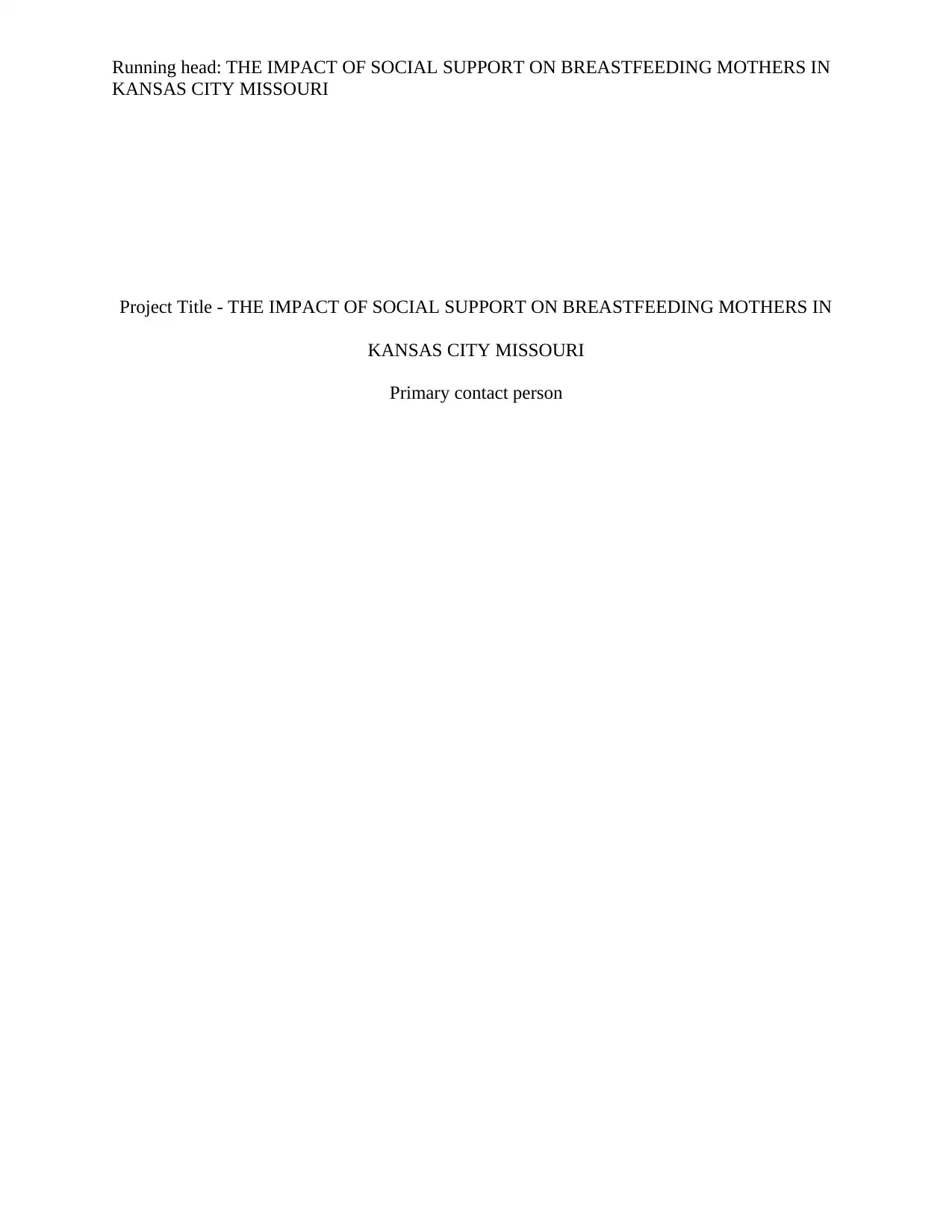
Running head: THE IMPACT OF SOCIAL SUPPORT ON BREASTFEEDING MOTHERS IN
KANSAS CITY MISSOURI
Project Title - THE IMPACT OF SOCIAL SUPPORT ON BREASTFEEDING MOTHERS IN
KANSAS CITY MISSOURI
Primary contact person
KANSAS CITY MISSOURI
Project Title - THE IMPACT OF SOCIAL SUPPORT ON BREASTFEEDING MOTHERS IN
KANSAS CITY MISSOURI
Primary contact person
Secure Best Marks with AI Grader
Need help grading? Try our AI Grader for instant feedback on your assignments.
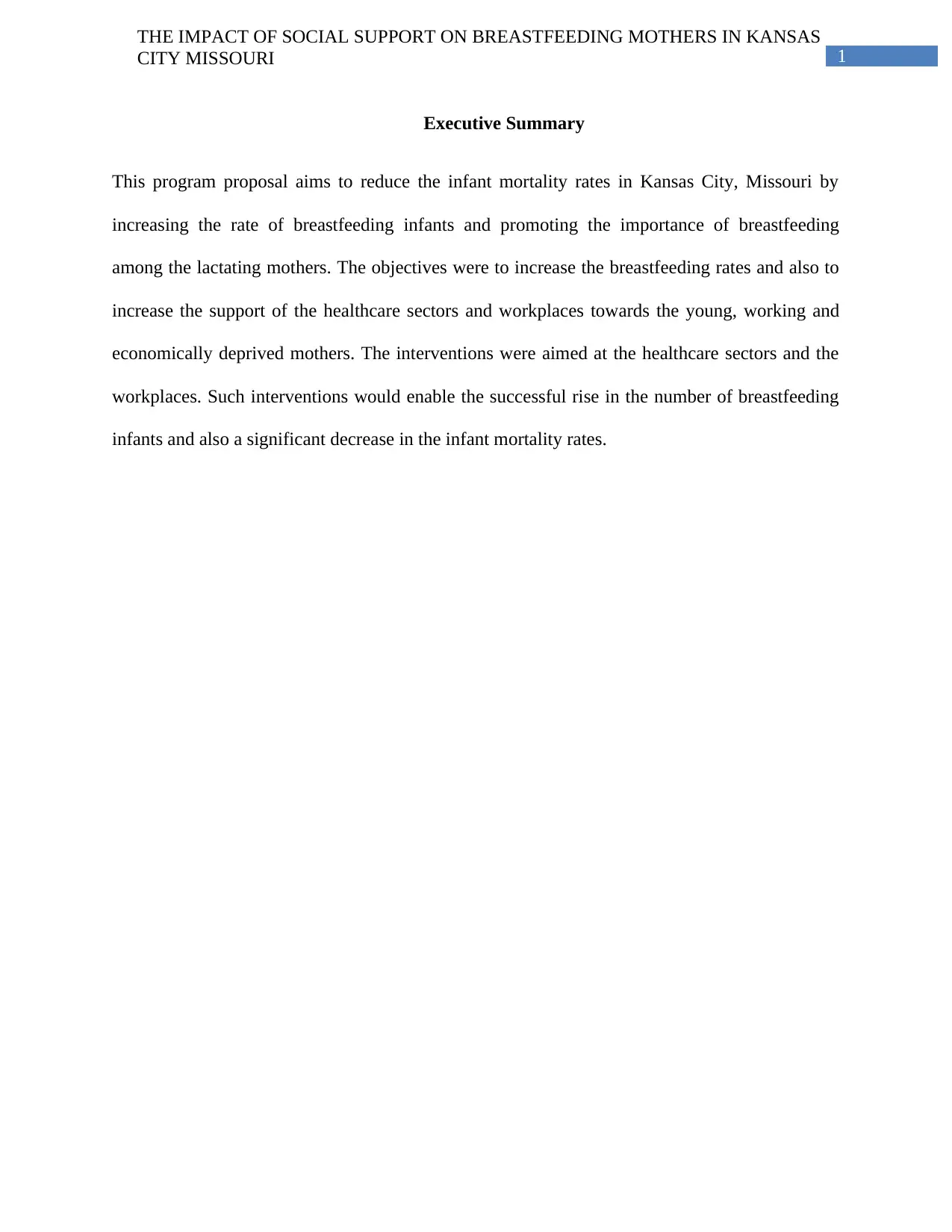
1
THE IMPACT OF SOCIAL SUPPORT ON BREASTFEEDING MOTHERS IN KANSAS
CITY MISSOURI
Executive Summary
This program proposal aims to reduce the infant mortality rates in Kansas City, Missouri by
increasing the rate of breastfeeding infants and promoting the importance of breastfeeding
among the lactating mothers. The objectives were to increase the breastfeeding rates and also to
increase the support of the healthcare sectors and workplaces towards the young, working and
economically deprived mothers. The interventions were aimed at the healthcare sectors and the
workplaces. Such interventions would enable the successful rise in the number of breastfeeding
infants and also a significant decrease in the infant mortality rates.
THE IMPACT OF SOCIAL SUPPORT ON BREASTFEEDING MOTHERS IN KANSAS
CITY MISSOURI
Executive Summary
This program proposal aims to reduce the infant mortality rates in Kansas City, Missouri by
increasing the rate of breastfeeding infants and promoting the importance of breastfeeding
among the lactating mothers. The objectives were to increase the breastfeeding rates and also to
increase the support of the healthcare sectors and workplaces towards the young, working and
economically deprived mothers. The interventions were aimed at the healthcare sectors and the
workplaces. Such interventions would enable the successful rise in the number of breastfeeding
infants and also a significant decrease in the infant mortality rates.
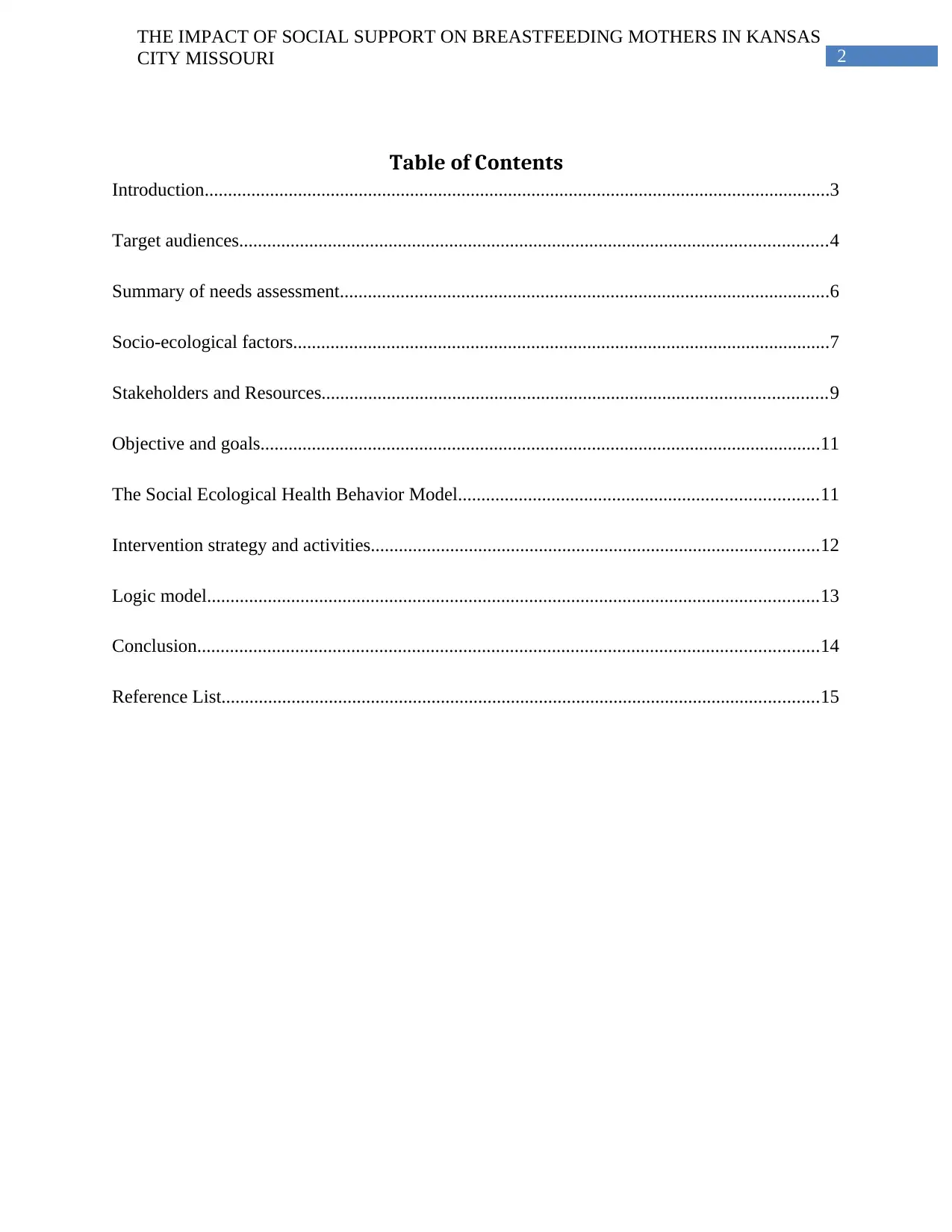
2
THE IMPACT OF SOCIAL SUPPORT ON BREASTFEEDING MOTHERS IN KANSAS
CITY MISSOURI
Table of Contents
Introduction......................................................................................................................................3
Target audiences..............................................................................................................................4
Summary of needs assessment.........................................................................................................6
Socio-ecological factors...................................................................................................................7
Stakeholders and Resources............................................................................................................9
Objective and goals........................................................................................................................11
The Social Ecological Health Behavior Model.............................................................................11
Intervention strategy and activities................................................................................................12
Logic model...................................................................................................................................13
Conclusion.....................................................................................................................................14
Reference List................................................................................................................................15
THE IMPACT OF SOCIAL SUPPORT ON BREASTFEEDING MOTHERS IN KANSAS
CITY MISSOURI
Table of Contents
Introduction......................................................................................................................................3
Target audiences..............................................................................................................................4
Summary of needs assessment.........................................................................................................6
Socio-ecological factors...................................................................................................................7
Stakeholders and Resources............................................................................................................9
Objective and goals........................................................................................................................11
The Social Ecological Health Behavior Model.............................................................................11
Intervention strategy and activities................................................................................................12
Logic model...................................................................................................................................13
Conclusion.....................................................................................................................................14
Reference List................................................................................................................................15
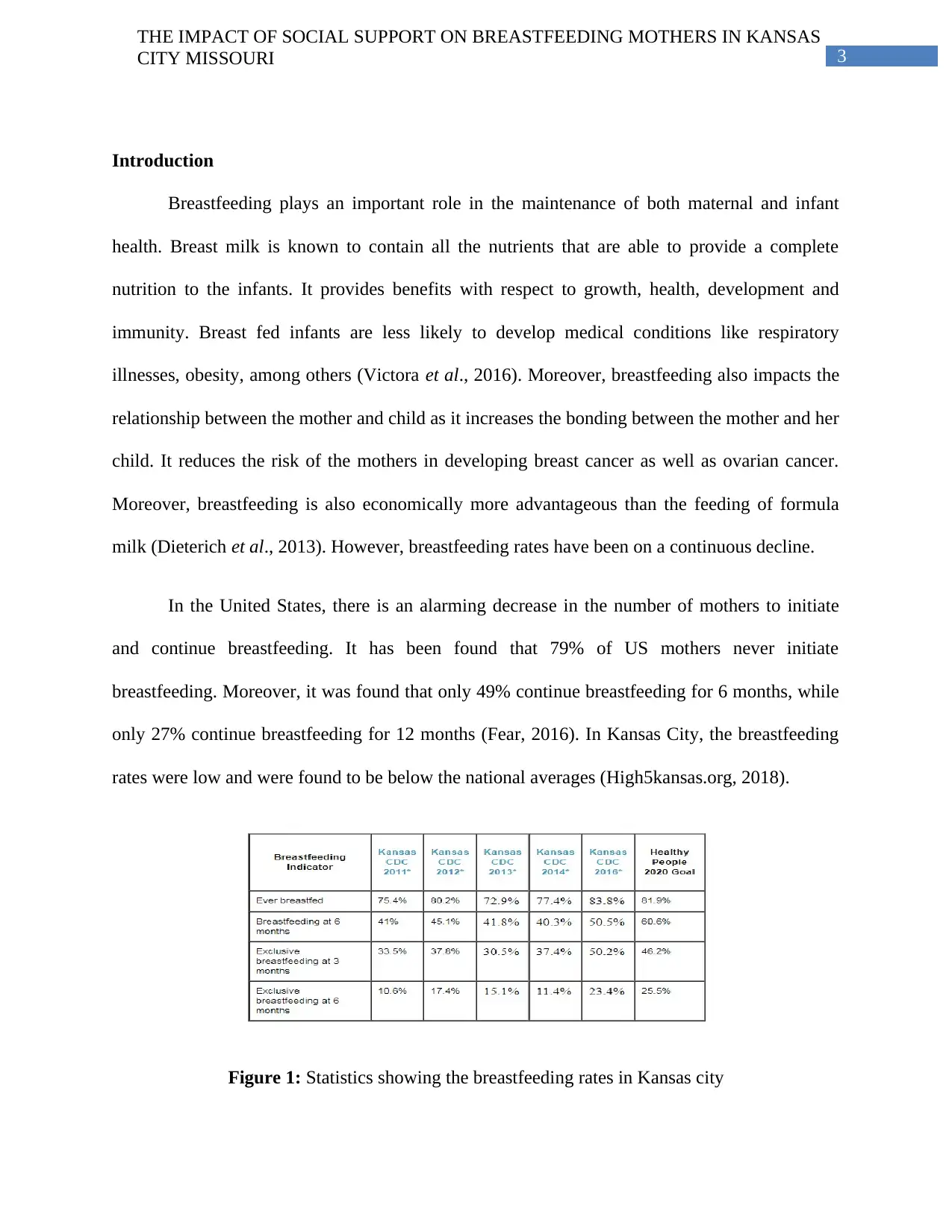
3
THE IMPACT OF SOCIAL SUPPORT ON BREASTFEEDING MOTHERS IN KANSAS
CITY MISSOURI
Introduction
Breastfeeding plays an important role in the maintenance of both maternal and infant
health. Breast milk is known to contain all the nutrients that are able to provide a complete
nutrition to the infants. It provides benefits with respect to growth, health, development and
immunity. Breast fed infants are less likely to develop medical conditions like respiratory
illnesses, obesity, among others (Victora et al., 2016). Moreover, breastfeeding also impacts the
relationship between the mother and child as it increases the bonding between the mother and her
child. It reduces the risk of the mothers in developing breast cancer as well as ovarian cancer.
Moreover, breastfeeding is also economically more advantageous than the feeding of formula
milk (Dieterich et al., 2013). However, breastfeeding rates have been on a continuous decline.
In the United States, there is an alarming decrease in the number of mothers to initiate
and continue breastfeeding. It has been found that 79% of US mothers never initiate
breastfeeding. Moreover, it was found that only 49% continue breastfeeding for 6 months, while
only 27% continue breastfeeding for 12 months (Fear, 2016). In Kansas City, the breastfeeding
rates were low and were found to be below the national averages (High5kansas.org, 2018).
Figure 1: Statistics showing the breastfeeding rates in Kansas city
THE IMPACT OF SOCIAL SUPPORT ON BREASTFEEDING MOTHERS IN KANSAS
CITY MISSOURI
Introduction
Breastfeeding plays an important role in the maintenance of both maternal and infant
health. Breast milk is known to contain all the nutrients that are able to provide a complete
nutrition to the infants. It provides benefits with respect to growth, health, development and
immunity. Breast fed infants are less likely to develop medical conditions like respiratory
illnesses, obesity, among others (Victora et al., 2016). Moreover, breastfeeding also impacts the
relationship between the mother and child as it increases the bonding between the mother and her
child. It reduces the risk of the mothers in developing breast cancer as well as ovarian cancer.
Moreover, breastfeeding is also economically more advantageous than the feeding of formula
milk (Dieterich et al., 2013). However, breastfeeding rates have been on a continuous decline.
In the United States, there is an alarming decrease in the number of mothers to initiate
and continue breastfeeding. It has been found that 79% of US mothers never initiate
breastfeeding. Moreover, it was found that only 49% continue breastfeeding for 6 months, while
only 27% continue breastfeeding for 12 months (Fear, 2016). In Kansas City, the breastfeeding
rates were low and were found to be below the national averages (High5kansas.org, 2018).
Figure 1: Statistics showing the breastfeeding rates in Kansas city
Paraphrase This Document
Need a fresh take? Get an instant paraphrase of this document with our AI Paraphraser
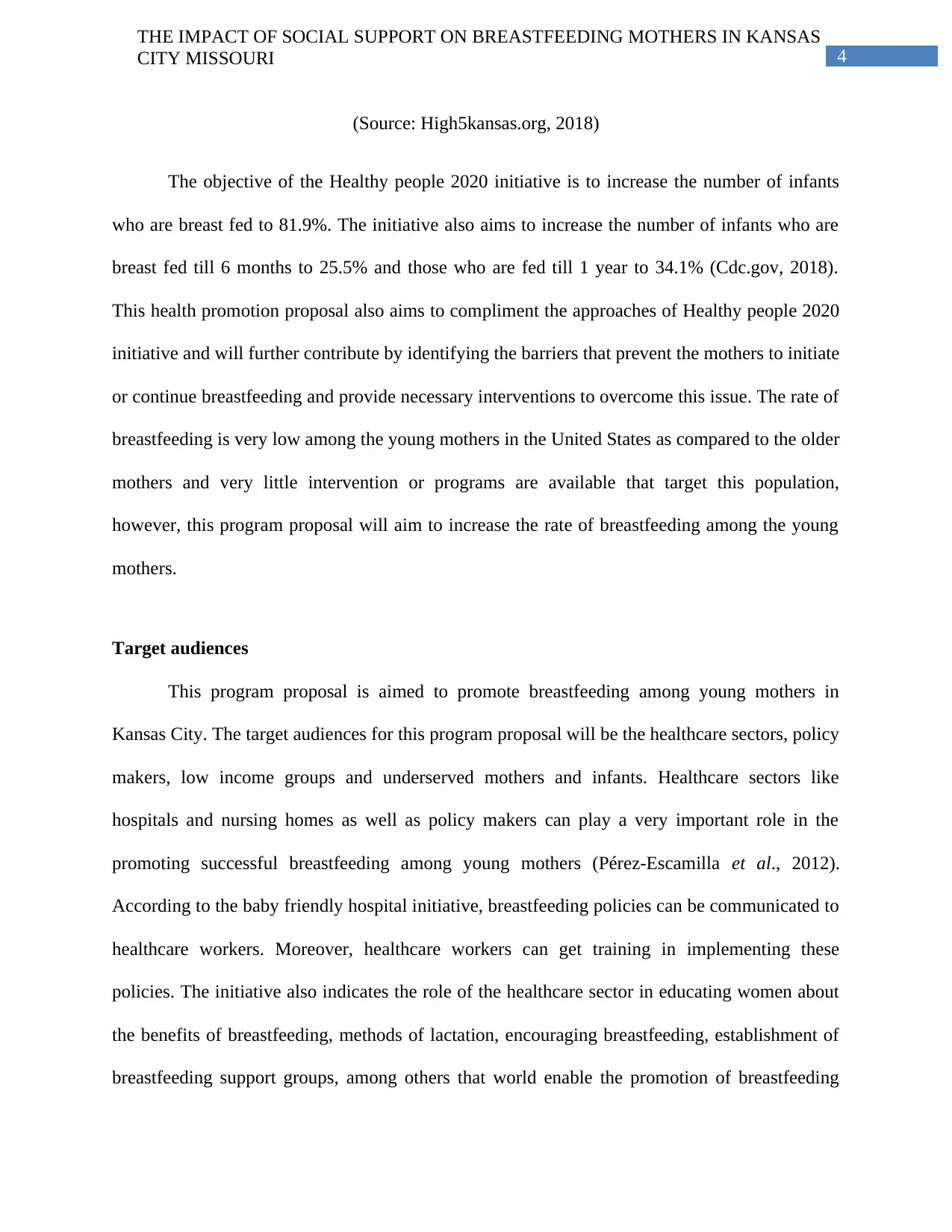
4
THE IMPACT OF SOCIAL SUPPORT ON BREASTFEEDING MOTHERS IN KANSAS
CITY MISSOURI
(Source: High5kansas.org, 2018)
The objective of the Healthy people 2020 initiative is to increase the number of infants
who are breast fed to 81.9%. The initiative also aims to increase the number of infants who are
breast fed till 6 months to 25.5% and those who are fed till 1 year to 34.1% (Cdc.gov, 2018).
This health promotion proposal also aims to compliment the approaches of Healthy people 2020
initiative and will further contribute by identifying the barriers that prevent the mothers to initiate
or continue breastfeeding and provide necessary interventions to overcome this issue. The rate of
breastfeeding is very low among the young mothers in the United States as compared to the older
mothers and very little intervention or programs are available that target this population,
however, this program proposal will aim to increase the rate of breastfeeding among the young
mothers.
Target audiences
This program proposal is aimed to promote breastfeeding among young mothers in
Kansas City. The target audiences for this program proposal will be the healthcare sectors, policy
makers, low income groups and underserved mothers and infants. Healthcare sectors like
hospitals and nursing homes as well as policy makers can play a very important role in the
promoting successful breastfeeding among young mothers (Pérez-Escamilla et al., 2012).
According to the baby friendly hospital initiative, breastfeeding policies can be communicated to
healthcare workers. Moreover, healthcare workers can get training in implementing these
policies. The initiative also indicates the role of the healthcare sector in educating women about
the benefits of breastfeeding, methods of lactation, encouraging breastfeeding, establishment of
breastfeeding support groups, among others that world enable the promotion of breastfeeding
THE IMPACT OF SOCIAL SUPPORT ON BREASTFEEDING MOTHERS IN KANSAS
CITY MISSOURI
(Source: High5kansas.org, 2018)
The objective of the Healthy people 2020 initiative is to increase the number of infants
who are breast fed to 81.9%. The initiative also aims to increase the number of infants who are
breast fed till 6 months to 25.5% and those who are fed till 1 year to 34.1% (Cdc.gov, 2018).
This health promotion proposal also aims to compliment the approaches of Healthy people 2020
initiative and will further contribute by identifying the barriers that prevent the mothers to initiate
or continue breastfeeding and provide necessary interventions to overcome this issue. The rate of
breastfeeding is very low among the young mothers in the United States as compared to the older
mothers and very little intervention or programs are available that target this population,
however, this program proposal will aim to increase the rate of breastfeeding among the young
mothers.
Target audiences
This program proposal is aimed to promote breastfeeding among young mothers in
Kansas City. The target audiences for this program proposal will be the healthcare sectors, policy
makers, low income groups and underserved mothers and infants. Healthcare sectors like
hospitals and nursing homes as well as policy makers can play a very important role in the
promoting successful breastfeeding among young mothers (Pérez-Escamilla et al., 2012).
According to the baby friendly hospital initiative, breastfeeding policies can be communicated to
healthcare workers. Moreover, healthcare workers can get training in implementing these
policies. The initiative also indicates the role of the healthcare sector in educating women about
the benefits of breastfeeding, methods of lactation, encouraging breastfeeding, establishment of
breastfeeding support groups, among others that world enable the promotion of breastfeeding
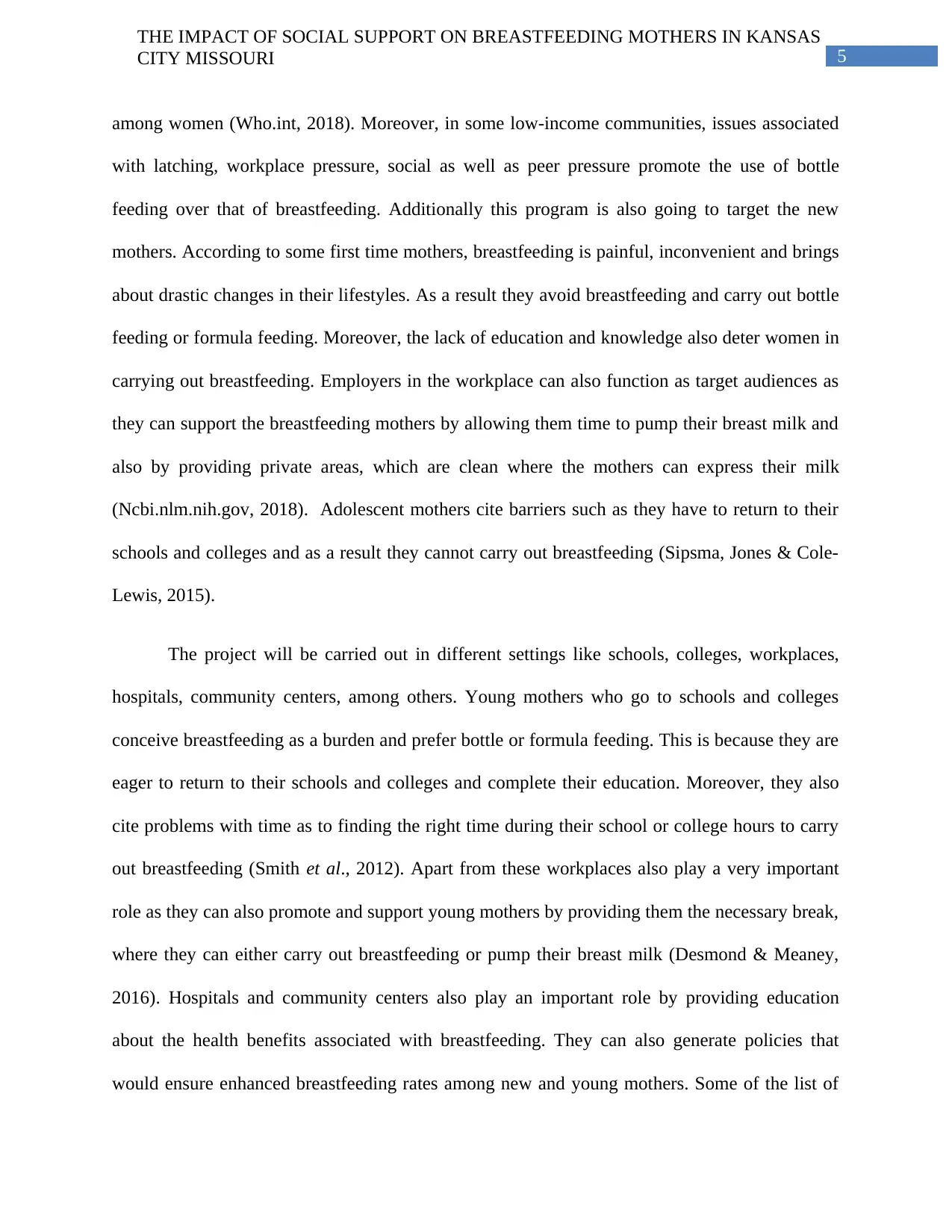
5
THE IMPACT OF SOCIAL SUPPORT ON BREASTFEEDING MOTHERS IN KANSAS
CITY MISSOURI
among women (Who.int, 2018). Moreover, in some low-income communities, issues associated
with latching, workplace pressure, social as well as peer pressure promote the use of bottle
feeding over that of breastfeeding. Additionally this program is also going to target the new
mothers. According to some first time mothers, breastfeeding is painful, inconvenient and brings
about drastic changes in their lifestyles. As a result they avoid breastfeeding and carry out bottle
feeding or formula feeding. Moreover, the lack of education and knowledge also deter women in
carrying out breastfeeding. Employers in the workplace can also function as target audiences as
they can support the breastfeeding mothers by allowing them time to pump their breast milk and
also by providing private areas, which are clean where the mothers can express their milk
(Ncbi.nlm.nih.gov, 2018). Adolescent mothers cite barriers such as they have to return to their
schools and colleges and as a result they cannot carry out breastfeeding (Sipsma, Jones & Cole-
Lewis, 2015).
The project will be carried out in different settings like schools, colleges, workplaces,
hospitals, community centers, among others. Young mothers who go to schools and colleges
conceive breastfeeding as a burden and prefer bottle or formula feeding. This is because they are
eager to return to their schools and colleges and complete their education. Moreover, they also
cite problems with time as to finding the right time during their school or college hours to carry
out breastfeeding (Smith et al., 2012). Apart from these workplaces also play a very important
role as they can also promote and support young mothers by providing them the necessary break,
where they can either carry out breastfeeding or pump their breast milk (Desmond & Meaney,
2016). Hospitals and community centers also play an important role by providing education
about the health benefits associated with breastfeeding. They can also generate policies that
would ensure enhanced breastfeeding rates among new and young mothers. Some of the list of
THE IMPACT OF SOCIAL SUPPORT ON BREASTFEEDING MOTHERS IN KANSAS
CITY MISSOURI
among women (Who.int, 2018). Moreover, in some low-income communities, issues associated
with latching, workplace pressure, social as well as peer pressure promote the use of bottle
feeding over that of breastfeeding. Additionally this program is also going to target the new
mothers. According to some first time mothers, breastfeeding is painful, inconvenient and brings
about drastic changes in their lifestyles. As a result they avoid breastfeeding and carry out bottle
feeding or formula feeding. Moreover, the lack of education and knowledge also deter women in
carrying out breastfeeding. Employers in the workplace can also function as target audiences as
they can support the breastfeeding mothers by allowing them time to pump their breast milk and
also by providing private areas, which are clean where the mothers can express their milk
(Ncbi.nlm.nih.gov, 2018). Adolescent mothers cite barriers such as they have to return to their
schools and colleges and as a result they cannot carry out breastfeeding (Sipsma, Jones & Cole-
Lewis, 2015).
The project will be carried out in different settings like schools, colleges, workplaces,
hospitals, community centers, among others. Young mothers who go to schools and colleges
conceive breastfeeding as a burden and prefer bottle or formula feeding. This is because they are
eager to return to their schools and colleges and complete their education. Moreover, they also
cite problems with time as to finding the right time during their school or college hours to carry
out breastfeeding (Smith et al., 2012). Apart from these workplaces also play a very important
role as they can also promote and support young mothers by providing them the necessary break,
where they can either carry out breastfeeding or pump their breast milk (Desmond & Meaney,
2016). Hospitals and community centers also play an important role by providing education
about the health benefits associated with breastfeeding. They can also generate policies that
would ensure enhanced breastfeeding rates among new and young mothers. Some of the list of
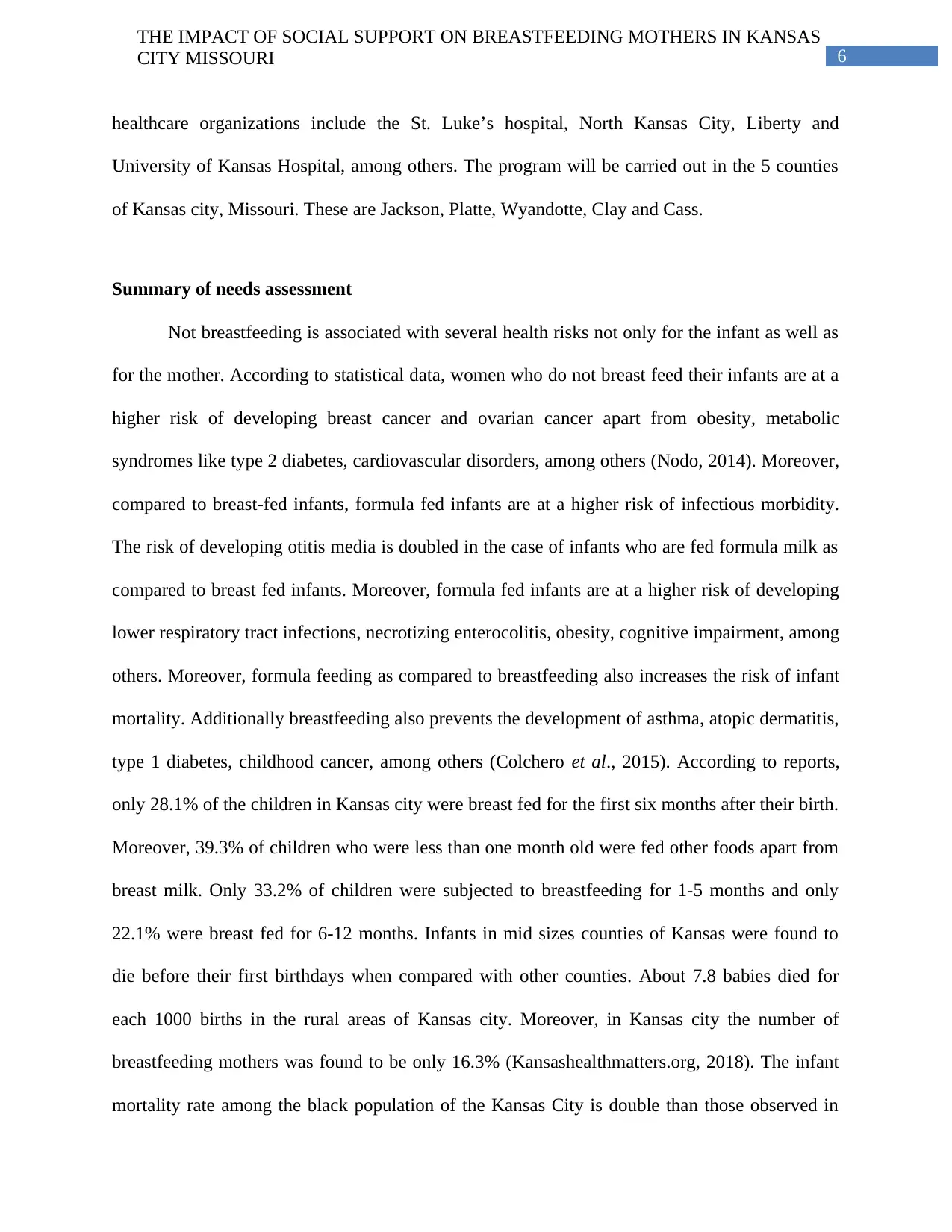
6
THE IMPACT OF SOCIAL SUPPORT ON BREASTFEEDING MOTHERS IN KANSAS
CITY MISSOURI
healthcare organizations include the St. Luke’s hospital, North Kansas City, Liberty and
University of Kansas Hospital, among others. The program will be carried out in the 5 counties
of Kansas city, Missouri. These are Jackson, Platte, Wyandotte, Clay and Cass.
Summary of needs assessment
Not breastfeeding is associated with several health risks not only for the infant as well as
for the mother. According to statistical data, women who do not breast feed their infants are at a
higher risk of developing breast cancer and ovarian cancer apart from obesity, metabolic
syndromes like type 2 diabetes, cardiovascular disorders, among others (Nodo, 2014). Moreover,
compared to breast-fed infants, formula fed infants are at a higher risk of infectious morbidity.
The risk of developing otitis media is doubled in the case of infants who are fed formula milk as
compared to breast fed infants. Moreover, formula fed infants are at a higher risk of developing
lower respiratory tract infections, necrotizing enterocolitis, obesity, cognitive impairment, among
others. Moreover, formula feeding as compared to breastfeeding also increases the risk of infant
mortality. Additionally breastfeeding also prevents the development of asthma, atopic dermatitis,
type 1 diabetes, childhood cancer, among others (Colchero et al., 2015). According to reports,
only 28.1% of the children in Kansas city were breast fed for the first six months after their birth.
Moreover, 39.3% of children who were less than one month old were fed other foods apart from
breast milk. Only 33.2% of children were subjected to breastfeeding for 1-5 months and only
22.1% were breast fed for 6-12 months. Infants in mid sizes counties of Kansas were found to
die before their first birthdays when compared with other counties. About 7.8 babies died for
each 1000 births in the rural areas of Kansas city. Moreover, in Kansas city the number of
breastfeeding mothers was found to be only 16.3% (Kansashealthmatters.org, 2018). The infant
mortality rate among the black population of the Kansas City is double than those observed in
THE IMPACT OF SOCIAL SUPPORT ON BREASTFEEDING MOTHERS IN KANSAS
CITY MISSOURI
healthcare organizations include the St. Luke’s hospital, North Kansas City, Liberty and
University of Kansas Hospital, among others. The program will be carried out in the 5 counties
of Kansas city, Missouri. These are Jackson, Platte, Wyandotte, Clay and Cass.
Summary of needs assessment
Not breastfeeding is associated with several health risks not only for the infant as well as
for the mother. According to statistical data, women who do not breast feed their infants are at a
higher risk of developing breast cancer and ovarian cancer apart from obesity, metabolic
syndromes like type 2 diabetes, cardiovascular disorders, among others (Nodo, 2014). Moreover,
compared to breast-fed infants, formula fed infants are at a higher risk of infectious morbidity.
The risk of developing otitis media is doubled in the case of infants who are fed formula milk as
compared to breast fed infants. Moreover, formula fed infants are at a higher risk of developing
lower respiratory tract infections, necrotizing enterocolitis, obesity, cognitive impairment, among
others. Moreover, formula feeding as compared to breastfeeding also increases the risk of infant
mortality. Additionally breastfeeding also prevents the development of asthma, atopic dermatitis,
type 1 diabetes, childhood cancer, among others (Colchero et al., 2015). According to reports,
only 28.1% of the children in Kansas city were breast fed for the first six months after their birth.
Moreover, 39.3% of children who were less than one month old were fed other foods apart from
breast milk. Only 33.2% of children were subjected to breastfeeding for 1-5 months and only
22.1% were breast fed for 6-12 months. Infants in mid sizes counties of Kansas were found to
die before their first birthdays when compared with other counties. About 7.8 babies died for
each 1000 births in the rural areas of Kansas city. Moreover, in Kansas city the number of
breastfeeding mothers was found to be only 16.3% (Kansashealthmatters.org, 2018). The infant
mortality rate among the black population of the Kansas City is double than those observed in
Secure Best Marks with AI Grader
Need help grading? Try our AI Grader for instant feedback on your assignments.
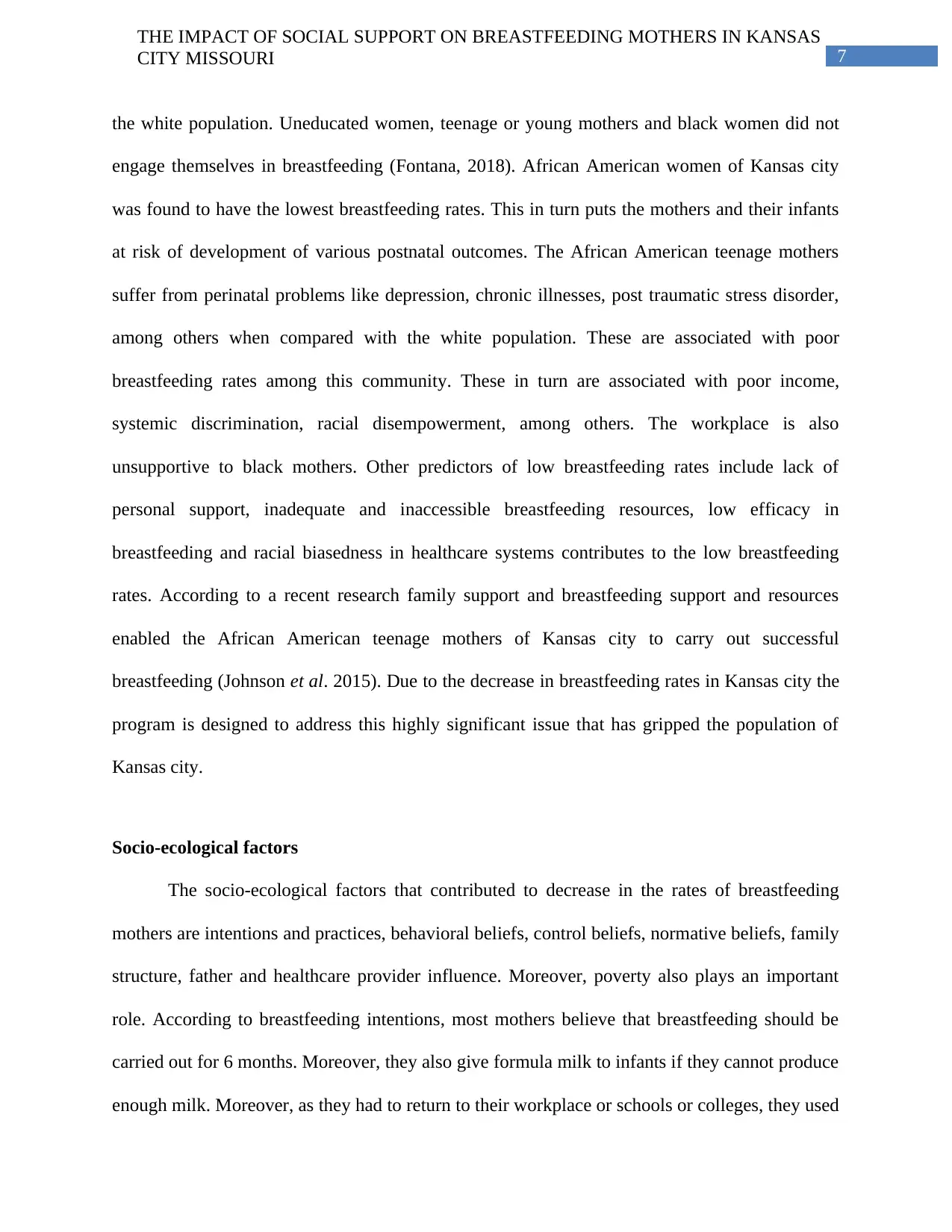
7
THE IMPACT OF SOCIAL SUPPORT ON BREASTFEEDING MOTHERS IN KANSAS
CITY MISSOURI
the white population. Uneducated women, teenage or young mothers and black women did not
engage themselves in breastfeeding (Fontana, 2018). African American women of Kansas city
was found to have the lowest breastfeeding rates. This in turn puts the mothers and their infants
at risk of development of various postnatal outcomes. The African American teenage mothers
suffer from perinatal problems like depression, chronic illnesses, post traumatic stress disorder,
among others when compared with the white population. These are associated with poor
breastfeeding rates among this community. These in turn are associated with poor income,
systemic discrimination, racial disempowerment, among others. The workplace is also
unsupportive to black mothers. Other predictors of low breastfeeding rates include lack of
personal support, inadequate and inaccessible breastfeeding resources, low efficacy in
breastfeeding and racial biasedness in healthcare systems contributes to the low breastfeeding
rates. According to a recent research family support and breastfeeding support and resources
enabled the African American teenage mothers of Kansas city to carry out successful
breastfeeding (Johnson et al. 2015). Due to the decrease in breastfeeding rates in Kansas city the
program is designed to address this highly significant issue that has gripped the population of
Kansas city.
Socio-ecological factors
The socio-ecological factors that contributed to decrease in the rates of breastfeeding
mothers are intentions and practices, behavioral beliefs, control beliefs, normative beliefs, family
structure, father and healthcare provider influence. Moreover, poverty also plays an important
role. According to breastfeeding intentions, most mothers believe that breastfeeding should be
carried out for 6 months. Moreover, they also give formula milk to infants if they cannot produce
enough milk. Moreover, as they had to return to their workplace or schools or colleges, they used
THE IMPACT OF SOCIAL SUPPORT ON BREASTFEEDING MOTHERS IN KANSAS
CITY MISSOURI
the white population. Uneducated women, teenage or young mothers and black women did not
engage themselves in breastfeeding (Fontana, 2018). African American women of Kansas city
was found to have the lowest breastfeeding rates. This in turn puts the mothers and their infants
at risk of development of various postnatal outcomes. The African American teenage mothers
suffer from perinatal problems like depression, chronic illnesses, post traumatic stress disorder,
among others when compared with the white population. These are associated with poor
breastfeeding rates among this community. These in turn are associated with poor income,
systemic discrimination, racial disempowerment, among others. The workplace is also
unsupportive to black mothers. Other predictors of low breastfeeding rates include lack of
personal support, inadequate and inaccessible breastfeeding resources, low efficacy in
breastfeeding and racial biasedness in healthcare systems contributes to the low breastfeeding
rates. According to a recent research family support and breastfeeding support and resources
enabled the African American teenage mothers of Kansas city to carry out successful
breastfeeding (Johnson et al. 2015). Due to the decrease in breastfeeding rates in Kansas city the
program is designed to address this highly significant issue that has gripped the population of
Kansas city.
Socio-ecological factors
The socio-ecological factors that contributed to decrease in the rates of breastfeeding
mothers are intentions and practices, behavioral beliefs, control beliefs, normative beliefs, family
structure, father and healthcare provider influence. Moreover, poverty also plays an important
role. According to breastfeeding intentions, most mothers believe that breastfeeding should be
carried out for 6 months. Moreover, they also give formula milk to infants if they cannot produce
enough milk. Moreover, as they had to return to their workplace or schools or colleges, they used
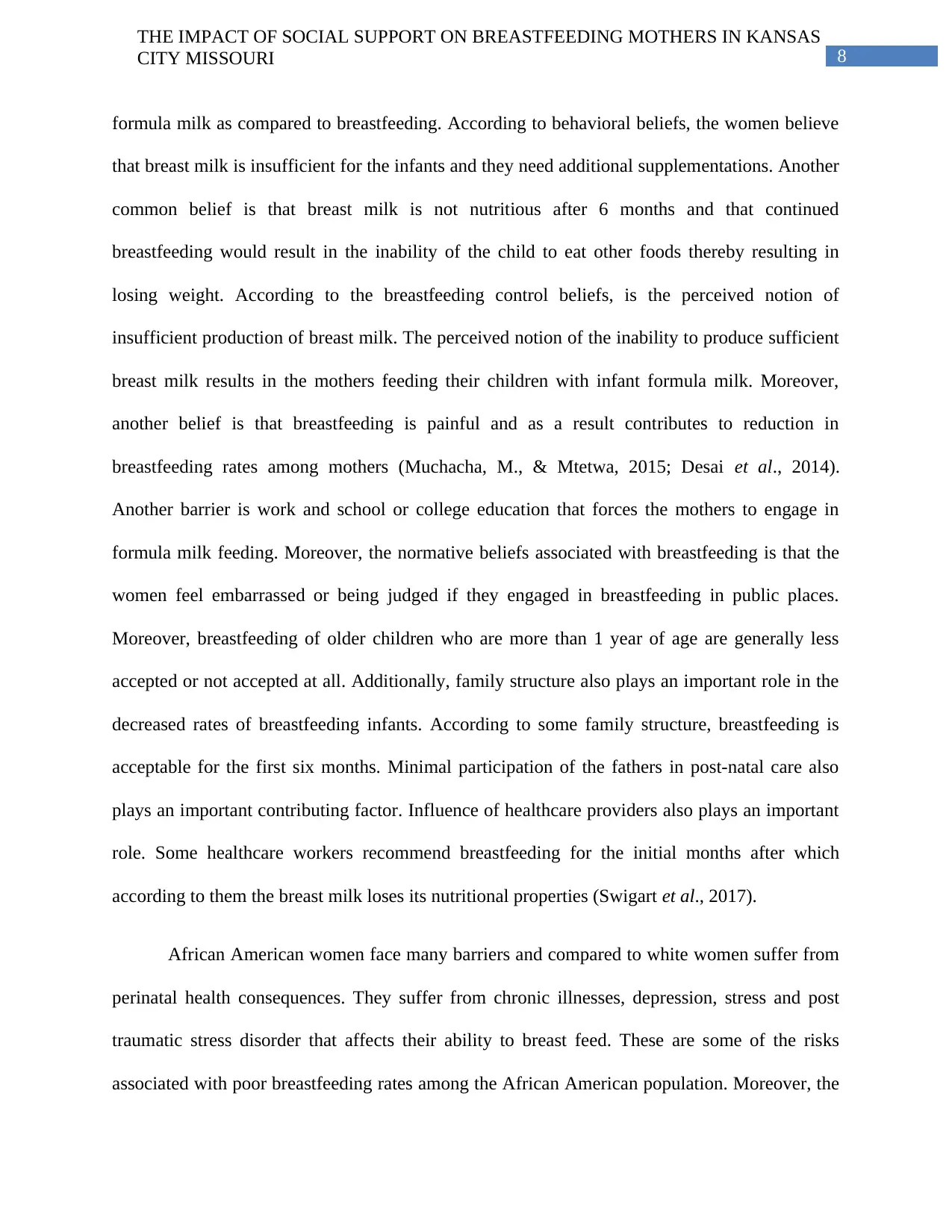
8
THE IMPACT OF SOCIAL SUPPORT ON BREASTFEEDING MOTHERS IN KANSAS
CITY MISSOURI
formula milk as compared to breastfeeding. According to behavioral beliefs, the women believe
that breast milk is insufficient for the infants and they need additional supplementations. Another
common belief is that breast milk is not nutritious after 6 months and that continued
breastfeeding would result in the inability of the child to eat other foods thereby resulting in
losing weight. According to the breastfeeding control beliefs, is the perceived notion of
insufficient production of breast milk. The perceived notion of the inability to produce sufficient
breast milk results in the mothers feeding their children with infant formula milk. Moreover,
another belief is that breastfeeding is painful and as a result contributes to reduction in
breastfeeding rates among mothers (Muchacha, M., & Mtetwa, 2015; Desai et al., 2014).
Another barrier is work and school or college education that forces the mothers to engage in
formula milk feeding. Moreover, the normative beliefs associated with breastfeeding is that the
women feel embarrassed or being judged if they engaged in breastfeeding in public places.
Moreover, breastfeeding of older children who are more than 1 year of age are generally less
accepted or not accepted at all. Additionally, family structure also plays an important role in the
decreased rates of breastfeeding infants. According to some family structure, breastfeeding is
acceptable for the first six months. Minimal participation of the fathers in post-natal care also
plays an important contributing factor. Influence of healthcare providers also plays an important
role. Some healthcare workers recommend breastfeeding for the initial months after which
according to them the breast milk loses its nutritional properties (Swigart et al., 2017).
African American women face many barriers and compared to white women suffer from
perinatal health consequences. They suffer from chronic illnesses, depression, stress and post
traumatic stress disorder that affects their ability to breast feed. These are some of the risks
associated with poor breastfeeding rates among the African American population. Moreover, the
THE IMPACT OF SOCIAL SUPPORT ON BREASTFEEDING MOTHERS IN KANSAS
CITY MISSOURI
formula milk as compared to breastfeeding. According to behavioral beliefs, the women believe
that breast milk is insufficient for the infants and they need additional supplementations. Another
common belief is that breast milk is not nutritious after 6 months and that continued
breastfeeding would result in the inability of the child to eat other foods thereby resulting in
losing weight. According to the breastfeeding control beliefs, is the perceived notion of
insufficient production of breast milk. The perceived notion of the inability to produce sufficient
breast milk results in the mothers feeding their children with infant formula milk. Moreover,
another belief is that breastfeeding is painful and as a result contributes to reduction in
breastfeeding rates among mothers (Muchacha, M., & Mtetwa, 2015; Desai et al., 2014).
Another barrier is work and school or college education that forces the mothers to engage in
formula milk feeding. Moreover, the normative beliefs associated with breastfeeding is that the
women feel embarrassed or being judged if they engaged in breastfeeding in public places.
Moreover, breastfeeding of older children who are more than 1 year of age are generally less
accepted or not accepted at all. Additionally, family structure also plays an important role in the
decreased rates of breastfeeding infants. According to some family structure, breastfeeding is
acceptable for the first six months. Minimal participation of the fathers in post-natal care also
plays an important contributing factor. Influence of healthcare providers also plays an important
role. Some healthcare workers recommend breastfeeding for the initial months after which
according to them the breast milk loses its nutritional properties (Swigart et al., 2017).
African American women face many barriers and compared to white women suffer from
perinatal health consequences. They suffer from chronic illnesses, depression, stress and post
traumatic stress disorder that affects their ability to breast feed. These are some of the risks
associated with poor breastfeeding rates among the African American population. Moreover, the
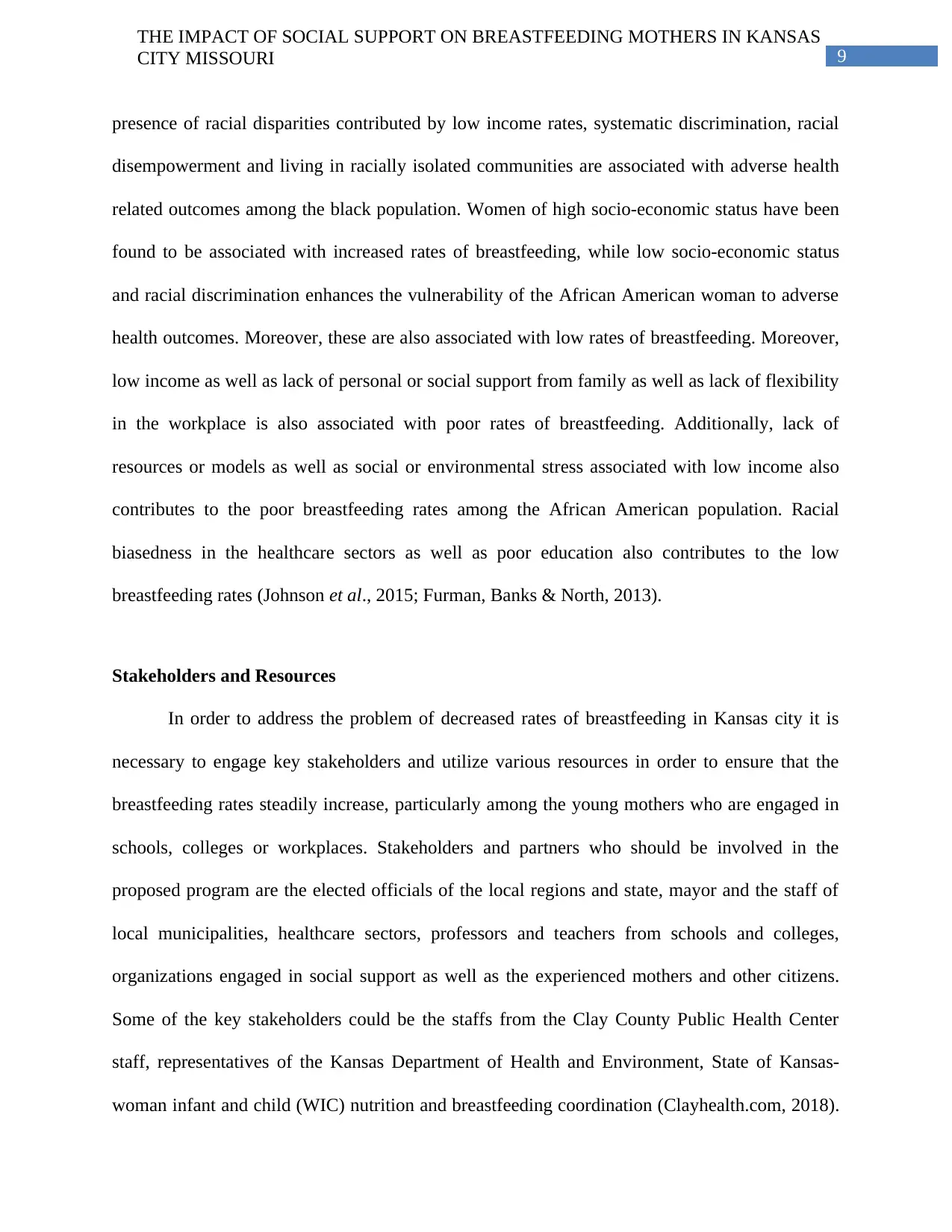
9
THE IMPACT OF SOCIAL SUPPORT ON BREASTFEEDING MOTHERS IN KANSAS
CITY MISSOURI
presence of racial disparities contributed by low income rates, systematic discrimination, racial
disempowerment and living in racially isolated communities are associated with adverse health
related outcomes among the black population. Women of high socio-economic status have been
found to be associated with increased rates of breastfeeding, while low socio-economic status
and racial discrimination enhances the vulnerability of the African American woman to adverse
health outcomes. Moreover, these are also associated with low rates of breastfeeding. Moreover,
low income as well as lack of personal or social support from family as well as lack of flexibility
in the workplace is also associated with poor rates of breastfeeding. Additionally, lack of
resources or models as well as social or environmental stress associated with low income also
contributes to the poor breastfeeding rates among the African American population. Racial
biasedness in the healthcare sectors as well as poor education also contributes to the low
breastfeeding rates (Johnson et al., 2015; Furman, Banks & North, 2013).
Stakeholders and Resources
In order to address the problem of decreased rates of breastfeeding in Kansas city it is
necessary to engage key stakeholders and utilize various resources in order to ensure that the
breastfeeding rates steadily increase, particularly among the young mothers who are engaged in
schools, colleges or workplaces. Stakeholders and partners who should be involved in the
proposed program are the elected officials of the local regions and state, mayor and the staff of
local municipalities, healthcare sectors, professors and teachers from schools and colleges,
organizations engaged in social support as well as the experienced mothers and other citizens.
Some of the key stakeholders could be the staffs from the Clay County Public Health Center
staff, representatives of the Kansas Department of Health and Environment, State of Kansas-
woman infant and child (WIC) nutrition and breastfeeding coordination (Clayhealth.com, 2018).
THE IMPACT OF SOCIAL SUPPORT ON BREASTFEEDING MOTHERS IN KANSAS
CITY MISSOURI
presence of racial disparities contributed by low income rates, systematic discrimination, racial
disempowerment and living in racially isolated communities are associated with adverse health
related outcomes among the black population. Women of high socio-economic status have been
found to be associated with increased rates of breastfeeding, while low socio-economic status
and racial discrimination enhances the vulnerability of the African American woman to adverse
health outcomes. Moreover, these are also associated with low rates of breastfeeding. Moreover,
low income as well as lack of personal or social support from family as well as lack of flexibility
in the workplace is also associated with poor rates of breastfeeding. Additionally, lack of
resources or models as well as social or environmental stress associated with low income also
contributes to the poor breastfeeding rates among the African American population. Racial
biasedness in the healthcare sectors as well as poor education also contributes to the low
breastfeeding rates (Johnson et al., 2015; Furman, Banks & North, 2013).
Stakeholders and Resources
In order to address the problem of decreased rates of breastfeeding in Kansas city it is
necessary to engage key stakeholders and utilize various resources in order to ensure that the
breastfeeding rates steadily increase, particularly among the young mothers who are engaged in
schools, colleges or workplaces. Stakeholders and partners who should be involved in the
proposed program are the elected officials of the local regions and state, mayor and the staff of
local municipalities, healthcare sectors, professors and teachers from schools and colleges,
organizations engaged in social support as well as the experienced mothers and other citizens.
Some of the key stakeholders could be the staffs from the Clay County Public Health Center
staff, representatives of the Kansas Department of Health and Environment, State of Kansas-
woman infant and child (WIC) nutrition and breastfeeding coordination (Clayhealth.com, 2018).
Paraphrase This Document
Need a fresh take? Get an instant paraphrase of this document with our AI Paraphraser
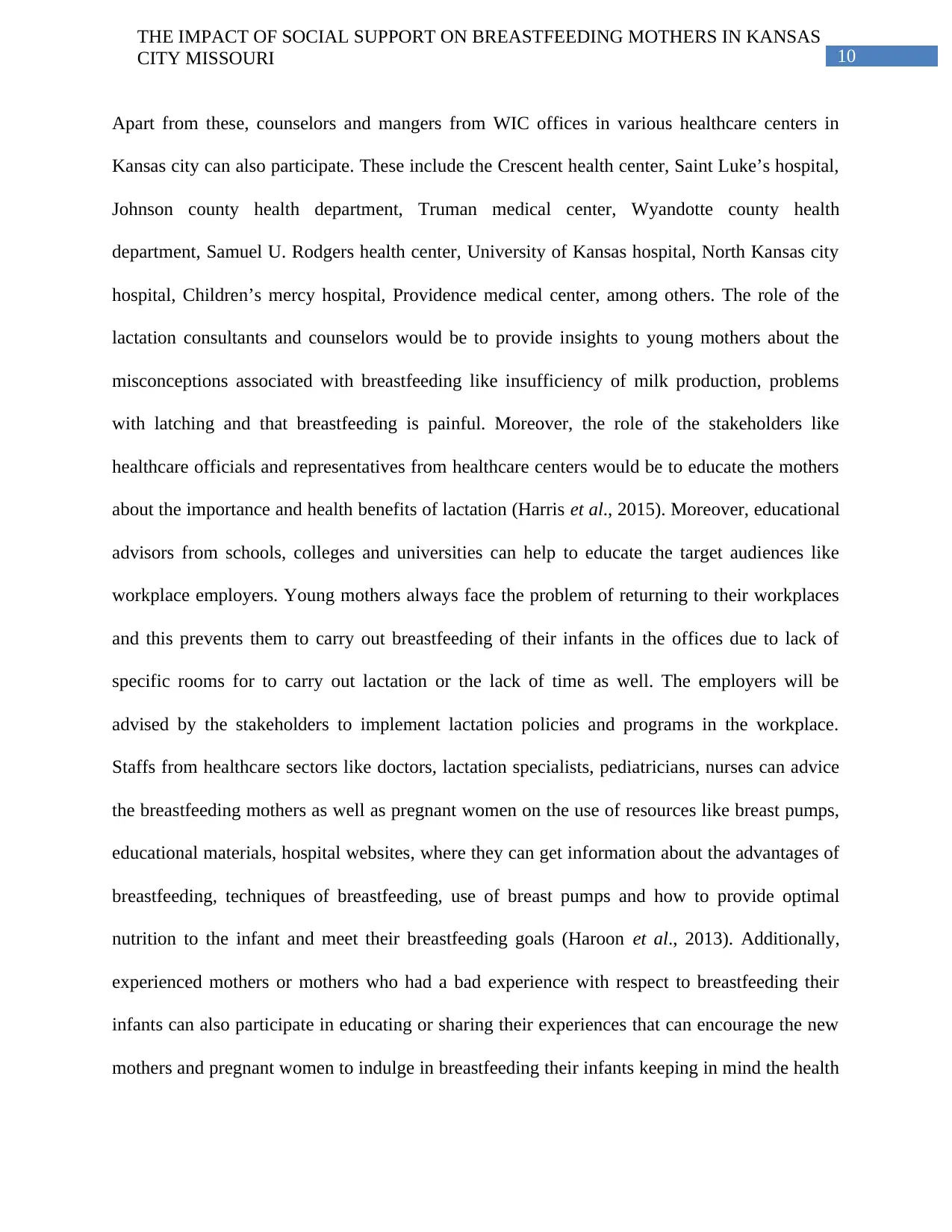
10
THE IMPACT OF SOCIAL SUPPORT ON BREASTFEEDING MOTHERS IN KANSAS
CITY MISSOURI
Apart from these, counselors and mangers from WIC offices in various healthcare centers in
Kansas city can also participate. These include the Crescent health center, Saint Luke’s hospital,
Johnson county health department, Truman medical center, Wyandotte county health
department, Samuel U. Rodgers health center, University of Kansas hospital, North Kansas city
hospital, Children’s mercy hospital, Providence medical center, among others. The role of the
lactation consultants and counselors would be to provide insights to young mothers about the
misconceptions associated with breastfeeding like insufficiency of milk production, problems
with latching and that breastfeeding is painful. Moreover, the role of the stakeholders like
healthcare officials and representatives from healthcare centers would be to educate the mothers
about the importance and health benefits of lactation (Harris et al., 2015). Moreover, educational
advisors from schools, colleges and universities can help to educate the target audiences like
workplace employers. Young mothers always face the problem of returning to their workplaces
and this prevents them to carry out breastfeeding of their infants in the offices due to lack of
specific rooms for to carry out lactation or the lack of time as well. The employers will be
advised by the stakeholders to implement lactation policies and programs in the workplace.
Staffs from healthcare sectors like doctors, lactation specialists, pediatricians, nurses can advice
the breastfeeding mothers as well as pregnant women on the use of resources like breast pumps,
educational materials, hospital websites, where they can get information about the advantages of
breastfeeding, techniques of breastfeeding, use of breast pumps and how to provide optimal
nutrition to the infant and meet their breastfeeding goals (Haroon et al., 2013). Additionally,
experienced mothers or mothers who had a bad experience with respect to breastfeeding their
infants can also participate in educating or sharing their experiences that can encourage the new
mothers and pregnant women to indulge in breastfeeding their infants keeping in mind the health
THE IMPACT OF SOCIAL SUPPORT ON BREASTFEEDING MOTHERS IN KANSAS
CITY MISSOURI
Apart from these, counselors and mangers from WIC offices in various healthcare centers in
Kansas city can also participate. These include the Crescent health center, Saint Luke’s hospital,
Johnson county health department, Truman medical center, Wyandotte county health
department, Samuel U. Rodgers health center, University of Kansas hospital, North Kansas city
hospital, Children’s mercy hospital, Providence medical center, among others. The role of the
lactation consultants and counselors would be to provide insights to young mothers about the
misconceptions associated with breastfeeding like insufficiency of milk production, problems
with latching and that breastfeeding is painful. Moreover, the role of the stakeholders like
healthcare officials and representatives from healthcare centers would be to educate the mothers
about the importance and health benefits of lactation (Harris et al., 2015). Moreover, educational
advisors from schools, colleges and universities can help to educate the target audiences like
workplace employers. Young mothers always face the problem of returning to their workplaces
and this prevents them to carry out breastfeeding of their infants in the offices due to lack of
specific rooms for to carry out lactation or the lack of time as well. The employers will be
advised by the stakeholders to implement lactation policies and programs in the workplace.
Staffs from healthcare sectors like doctors, lactation specialists, pediatricians, nurses can advice
the breastfeeding mothers as well as pregnant women on the use of resources like breast pumps,
educational materials, hospital websites, where they can get information about the advantages of
breastfeeding, techniques of breastfeeding, use of breast pumps and how to provide optimal
nutrition to the infant and meet their breastfeeding goals (Haroon et al., 2013). Additionally,
experienced mothers or mothers who had a bad experience with respect to breastfeeding their
infants can also participate in educating or sharing their experiences that can encourage the new
mothers and pregnant women to indulge in breastfeeding their infants keeping in mind the health
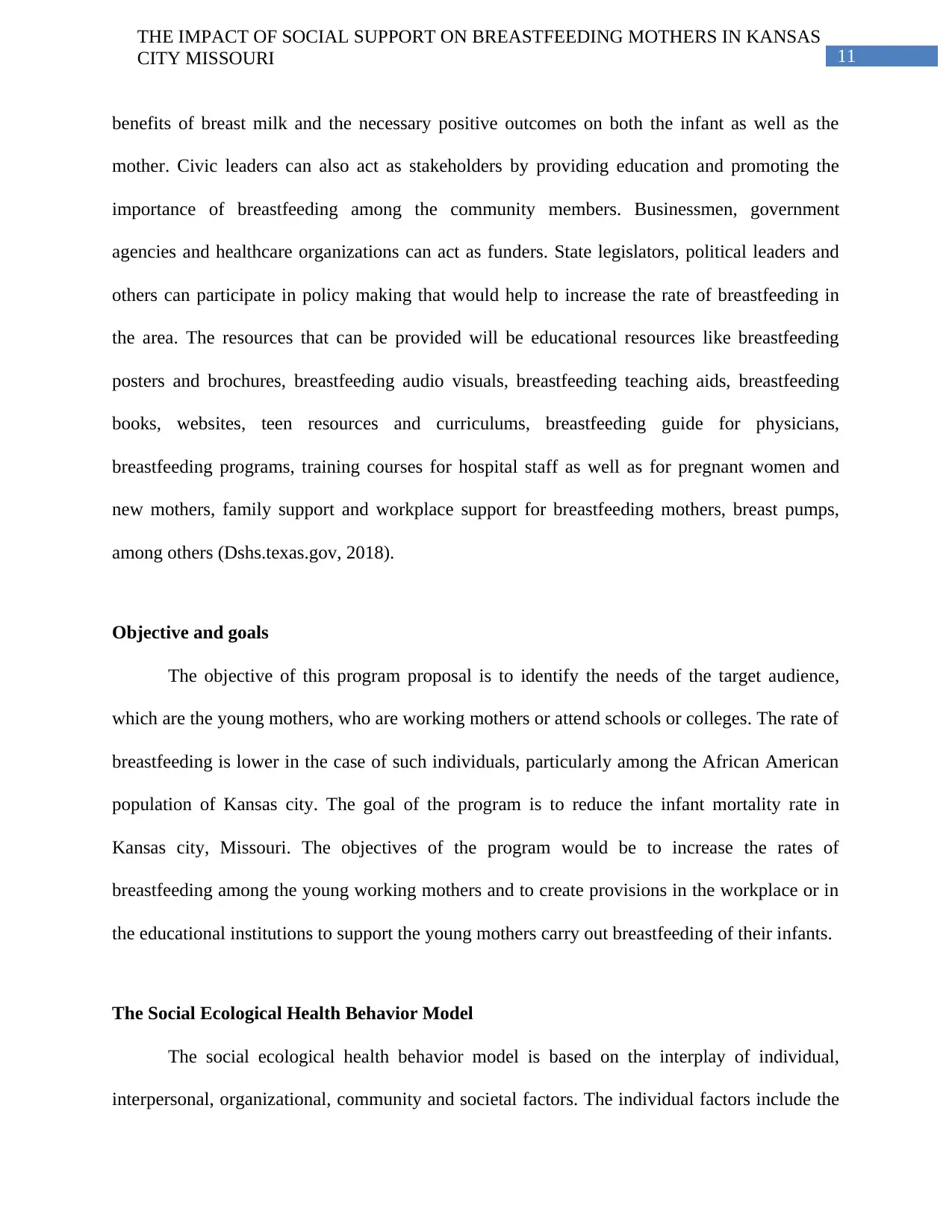
11
THE IMPACT OF SOCIAL SUPPORT ON BREASTFEEDING MOTHERS IN KANSAS
CITY MISSOURI
benefits of breast milk and the necessary positive outcomes on both the infant as well as the
mother. Civic leaders can also act as stakeholders by providing education and promoting the
importance of breastfeeding among the community members. Businessmen, government
agencies and healthcare organizations can act as funders. State legislators, political leaders and
others can participate in policy making that would help to increase the rate of breastfeeding in
the area. The resources that can be provided will be educational resources like breastfeeding
posters and brochures, breastfeeding audio visuals, breastfeeding teaching aids, breastfeeding
books, websites, teen resources and curriculums, breastfeeding guide for physicians,
breastfeeding programs, training courses for hospital staff as well as for pregnant women and
new mothers, family support and workplace support for breastfeeding mothers, breast pumps,
among others (Dshs.texas.gov, 2018).
Objective and goals
The objective of this program proposal is to identify the needs of the target audience,
which are the young mothers, who are working mothers or attend schools or colleges. The rate of
breastfeeding is lower in the case of such individuals, particularly among the African American
population of Kansas city. The goal of the program is to reduce the infant mortality rate in
Kansas city, Missouri. The objectives of the program would be to increase the rates of
breastfeeding among the young working mothers and to create provisions in the workplace or in
the educational institutions to support the young mothers carry out breastfeeding of their infants.
The Social Ecological Health Behavior Model
The social ecological health behavior model is based on the interplay of individual,
interpersonal, organizational, community and societal factors. The individual factors include the
THE IMPACT OF SOCIAL SUPPORT ON BREASTFEEDING MOTHERS IN KANSAS
CITY MISSOURI
benefits of breast milk and the necessary positive outcomes on both the infant as well as the
mother. Civic leaders can also act as stakeholders by providing education and promoting the
importance of breastfeeding among the community members. Businessmen, government
agencies and healthcare organizations can act as funders. State legislators, political leaders and
others can participate in policy making that would help to increase the rate of breastfeeding in
the area. The resources that can be provided will be educational resources like breastfeeding
posters and brochures, breastfeeding audio visuals, breastfeeding teaching aids, breastfeeding
books, websites, teen resources and curriculums, breastfeeding guide for physicians,
breastfeeding programs, training courses for hospital staff as well as for pregnant women and
new mothers, family support and workplace support for breastfeeding mothers, breast pumps,
among others (Dshs.texas.gov, 2018).
Objective and goals
The objective of this program proposal is to identify the needs of the target audience,
which are the young mothers, who are working mothers or attend schools or colleges. The rate of
breastfeeding is lower in the case of such individuals, particularly among the African American
population of Kansas city. The goal of the program is to reduce the infant mortality rate in
Kansas city, Missouri. The objectives of the program would be to increase the rates of
breastfeeding among the young working mothers and to create provisions in the workplace or in
the educational institutions to support the young mothers carry out breastfeeding of their infants.
The Social Ecological Health Behavior Model
The social ecological health behavior model is based on the interplay of individual,
interpersonal, organizational, community and societal factors. The individual factors include the
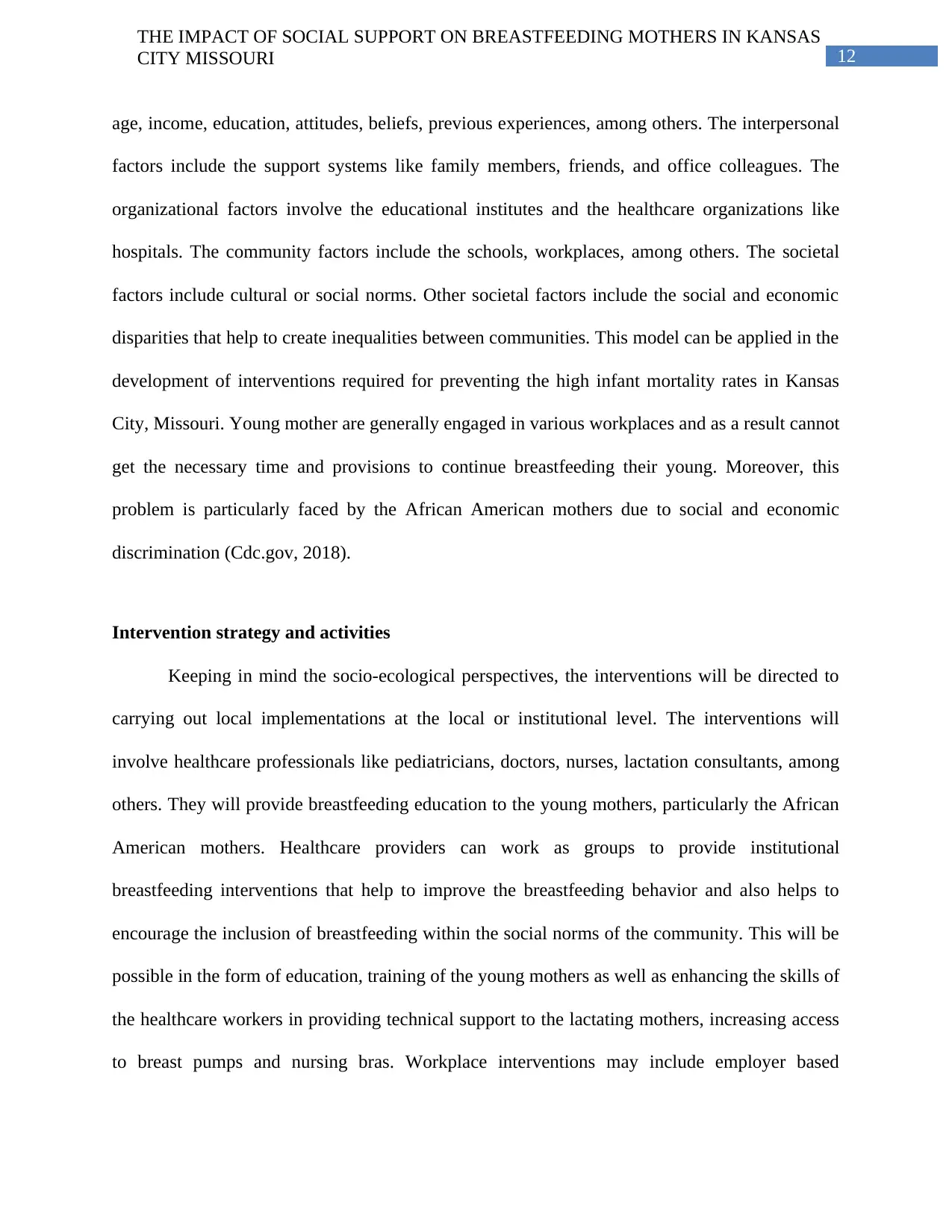
12
THE IMPACT OF SOCIAL SUPPORT ON BREASTFEEDING MOTHERS IN KANSAS
CITY MISSOURI
age, income, education, attitudes, beliefs, previous experiences, among others. The interpersonal
factors include the support systems like family members, friends, and office colleagues. The
organizational factors involve the educational institutes and the healthcare organizations like
hospitals. The community factors include the schools, workplaces, among others. The societal
factors include cultural or social norms. Other societal factors include the social and economic
disparities that help to create inequalities between communities. This model can be applied in the
development of interventions required for preventing the high infant mortality rates in Kansas
City, Missouri. Young mother are generally engaged in various workplaces and as a result cannot
get the necessary time and provisions to continue breastfeeding their young. Moreover, this
problem is particularly faced by the African American mothers due to social and economic
discrimination (Cdc.gov, 2018).
Intervention strategy and activities
Keeping in mind the socio-ecological perspectives, the interventions will be directed to
carrying out local implementations at the local or institutional level. The interventions will
involve healthcare professionals like pediatricians, doctors, nurses, lactation consultants, among
others. They will provide breastfeeding education to the young mothers, particularly the African
American mothers. Healthcare providers can work as groups to provide institutional
breastfeeding interventions that help to improve the breastfeeding behavior and also helps to
encourage the inclusion of breastfeeding within the social norms of the community. This will be
possible in the form of education, training of the young mothers as well as enhancing the skills of
the healthcare workers in providing technical support to the lactating mothers, increasing access
to breast pumps and nursing bras. Workplace interventions may include employer based
THE IMPACT OF SOCIAL SUPPORT ON BREASTFEEDING MOTHERS IN KANSAS
CITY MISSOURI
age, income, education, attitudes, beliefs, previous experiences, among others. The interpersonal
factors include the support systems like family members, friends, and office colleagues. The
organizational factors involve the educational institutes and the healthcare organizations like
hospitals. The community factors include the schools, workplaces, among others. The societal
factors include cultural or social norms. Other societal factors include the social and economic
disparities that help to create inequalities between communities. This model can be applied in the
development of interventions required for preventing the high infant mortality rates in Kansas
City, Missouri. Young mother are generally engaged in various workplaces and as a result cannot
get the necessary time and provisions to continue breastfeeding their young. Moreover, this
problem is particularly faced by the African American mothers due to social and economic
discrimination (Cdc.gov, 2018).
Intervention strategy and activities
Keeping in mind the socio-ecological perspectives, the interventions will be directed to
carrying out local implementations at the local or institutional level. The interventions will
involve healthcare professionals like pediatricians, doctors, nurses, lactation consultants, among
others. They will provide breastfeeding education to the young mothers, particularly the African
American mothers. Healthcare providers can work as groups to provide institutional
breastfeeding interventions that help to improve the breastfeeding behavior and also helps to
encourage the inclusion of breastfeeding within the social norms of the community. This will be
possible in the form of education, training of the young mothers as well as enhancing the skills of
the healthcare workers in providing technical support to the lactating mothers, increasing access
to breast pumps and nursing bras. Workplace interventions may include employer based
Secure Best Marks with AI Grader
Need help grading? Try our AI Grader for instant feedback on your assignments.
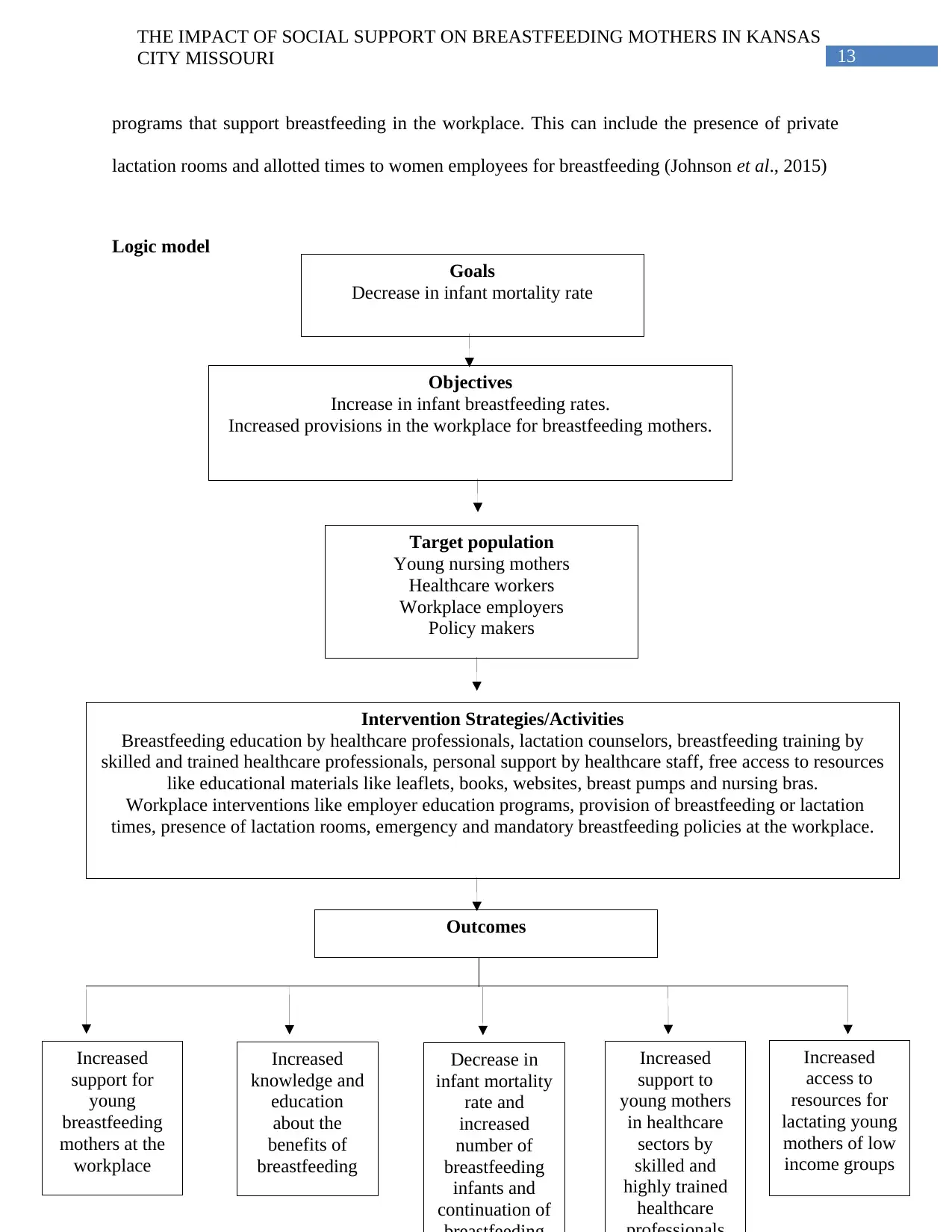
13
THE IMPACT OF SOCIAL SUPPORT ON BREASTFEEDING MOTHERS IN KANSAS
CITY MISSOURI
Goals
Decrease in infant mortality rate
Objectives
Increase in infant breastfeeding rates.
Increased provisions in the workplace for breastfeeding mothers.
Outcomes
Increased
support for
young
breastfeeding
mothers at the
workplace
Increased
knowledge and
education
about the
benefits of
breastfeeding
Decrease in
infant mortality
rate and
increased
number of
breastfeeding
infants and
continuation of
Increased
support to
young mothers
in healthcare
sectors by
skilled and
highly trained
healthcare
Increased
access to
resources for
lactating young
mothers of low
income groups
Target population
Young nursing mothers
Healthcare workers
Workplace employers
Policy makers
Intervention Strategies/Activities
Breastfeeding education by healthcare professionals, lactation counselors, breastfeeding training by
skilled and trained healthcare professionals, personal support by healthcare staff, free access to resources
like educational materials like leaflets, books, websites, breast pumps and nursing bras.
Workplace interventions like employer education programs, provision of breastfeeding or lactation
times, presence of lactation rooms, emergency and mandatory breastfeeding policies at the workplace.
programs that support breastfeeding in the workplace. This can include the presence of private
lactation rooms and allotted times to women employees for breastfeeding (Johnson et al., 2015)
Logic model
THE IMPACT OF SOCIAL SUPPORT ON BREASTFEEDING MOTHERS IN KANSAS
CITY MISSOURI
Goals
Decrease in infant mortality rate
Objectives
Increase in infant breastfeeding rates.
Increased provisions in the workplace for breastfeeding mothers.
Outcomes
Increased
support for
young
breastfeeding
mothers at the
workplace
Increased
knowledge and
education
about the
benefits of
breastfeeding
Decrease in
infant mortality
rate and
increased
number of
breastfeeding
infants and
continuation of
Increased
support to
young mothers
in healthcare
sectors by
skilled and
highly trained
healthcare
Increased
access to
resources for
lactating young
mothers of low
income groups
Target population
Young nursing mothers
Healthcare workers
Workplace employers
Policy makers
Intervention Strategies/Activities
Breastfeeding education by healthcare professionals, lactation counselors, breastfeeding training by
skilled and trained healthcare professionals, personal support by healthcare staff, free access to resources
like educational materials like leaflets, books, websites, breast pumps and nursing bras.
Workplace interventions like employer education programs, provision of breastfeeding or lactation
times, presence of lactation rooms, emergency and mandatory breastfeeding policies at the workplace.
programs that support breastfeeding in the workplace. This can include the presence of private
lactation rooms and allotted times to women employees for breastfeeding (Johnson et al., 2015)
Logic model
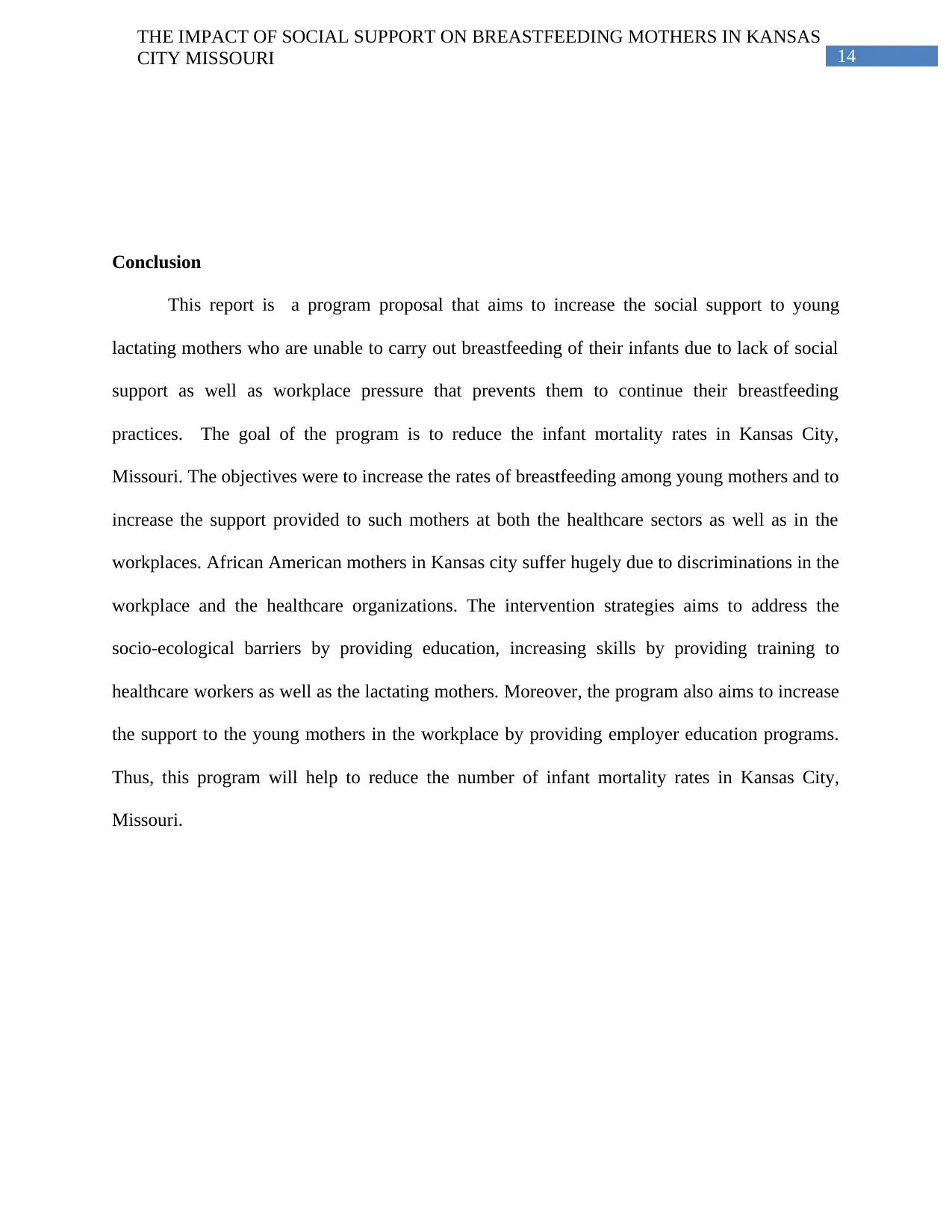
14
THE IMPACT OF SOCIAL SUPPORT ON BREASTFEEDING MOTHERS IN KANSAS
CITY MISSOURI
Conclusion
This report is a program proposal that aims to increase the social support to young
lactating mothers who are unable to carry out breastfeeding of their infants due to lack of social
support as well as workplace pressure that prevents them to continue their breastfeeding
practices. The goal of the program is to reduce the infant mortality rates in Kansas City,
Missouri. The objectives were to increase the rates of breastfeeding among young mothers and to
increase the support provided to such mothers at both the healthcare sectors as well as in the
workplaces. African American mothers in Kansas city suffer hugely due to discriminations in the
workplace and the healthcare organizations. The intervention strategies aims to address the
socio-ecological barriers by providing education, increasing skills by providing training to
healthcare workers as well as the lactating mothers. Moreover, the program also aims to increase
the support to the young mothers in the workplace by providing employer education programs.
Thus, this program will help to reduce the number of infant mortality rates in Kansas City,
Missouri.
THE IMPACT OF SOCIAL SUPPORT ON BREASTFEEDING MOTHERS IN KANSAS
CITY MISSOURI
Conclusion
This report is a program proposal that aims to increase the social support to young
lactating mothers who are unable to carry out breastfeeding of their infants due to lack of social
support as well as workplace pressure that prevents them to continue their breastfeeding
practices. The goal of the program is to reduce the infant mortality rates in Kansas City,
Missouri. The objectives were to increase the rates of breastfeeding among young mothers and to
increase the support provided to such mothers at both the healthcare sectors as well as in the
workplaces. African American mothers in Kansas city suffer hugely due to discriminations in the
workplace and the healthcare organizations. The intervention strategies aims to address the
socio-ecological barriers by providing education, increasing skills by providing training to
healthcare workers as well as the lactating mothers. Moreover, the program also aims to increase
the support to the young mothers in the workplace by providing employer education programs.
Thus, this program will help to reduce the number of infant mortality rates in Kansas City,
Missouri.
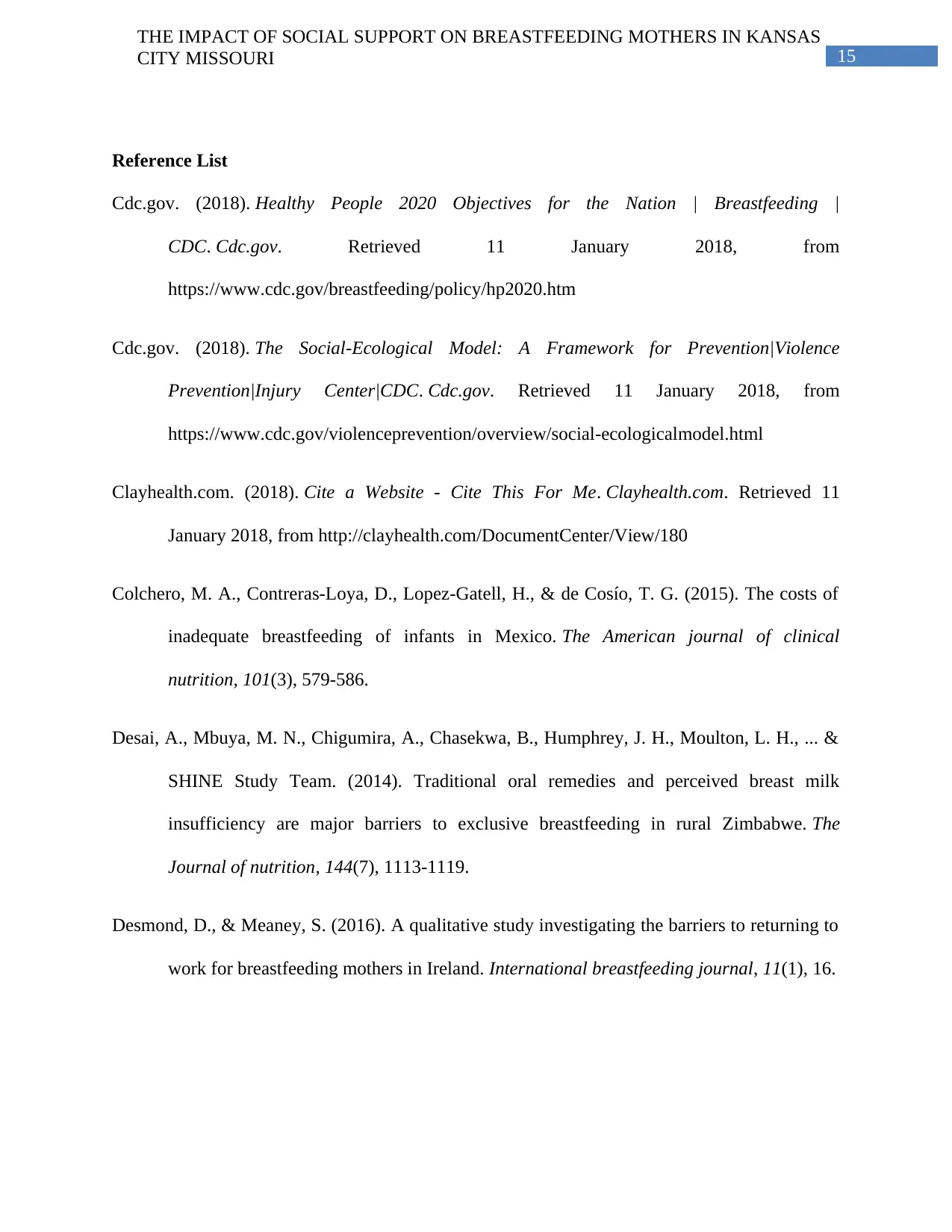
15
THE IMPACT OF SOCIAL SUPPORT ON BREASTFEEDING MOTHERS IN KANSAS
CITY MISSOURI
Reference List
Cdc.gov. (2018). Healthy People 2020 Objectives for the Nation | Breastfeeding |
CDC. Cdc.gov. Retrieved 11 January 2018, from
https://www.cdc.gov/breastfeeding/policy/hp2020.htm
Cdc.gov. (2018). The Social-Ecological Model: A Framework for Prevention|Violence
Prevention|Injury Center|CDC. Cdc.gov. Retrieved 11 January 2018, from
https://www.cdc.gov/violenceprevention/overview/social-ecologicalmodel.html
Clayhealth.com. (2018). Cite a Website - Cite This For Me. Clayhealth.com. Retrieved 11
January 2018, from http://clayhealth.com/DocumentCenter/View/180
Colchero, M. A., Contreras-Loya, D., Lopez-Gatell, H., & de Cosío, T. G. (2015). The costs of
inadequate breastfeeding of infants in Mexico. The American journal of clinical
nutrition, 101(3), 579-586.
Desai, A., Mbuya, M. N., Chigumira, A., Chasekwa, B., Humphrey, J. H., Moulton, L. H., ... &
SHINE Study Team. (2014). Traditional oral remedies and perceived breast milk
insufficiency are major barriers to exclusive breastfeeding in rural Zimbabwe. The
Journal of nutrition, 144(7), 1113-1119.
Desmond, D., & Meaney, S. (2016). A qualitative study investigating the barriers to returning to
work for breastfeeding mothers in Ireland. International breastfeeding journal, 11(1), 16.
THE IMPACT OF SOCIAL SUPPORT ON BREASTFEEDING MOTHERS IN KANSAS
CITY MISSOURI
Reference List
Cdc.gov. (2018). Healthy People 2020 Objectives for the Nation | Breastfeeding |
CDC. Cdc.gov. Retrieved 11 January 2018, from
https://www.cdc.gov/breastfeeding/policy/hp2020.htm
Cdc.gov. (2018). The Social-Ecological Model: A Framework for Prevention|Violence
Prevention|Injury Center|CDC. Cdc.gov. Retrieved 11 January 2018, from
https://www.cdc.gov/violenceprevention/overview/social-ecologicalmodel.html
Clayhealth.com. (2018). Cite a Website - Cite This For Me. Clayhealth.com. Retrieved 11
January 2018, from http://clayhealth.com/DocumentCenter/View/180
Colchero, M. A., Contreras-Loya, D., Lopez-Gatell, H., & de Cosío, T. G. (2015). The costs of
inadequate breastfeeding of infants in Mexico. The American journal of clinical
nutrition, 101(3), 579-586.
Desai, A., Mbuya, M. N., Chigumira, A., Chasekwa, B., Humphrey, J. H., Moulton, L. H., ... &
SHINE Study Team. (2014). Traditional oral remedies and perceived breast milk
insufficiency are major barriers to exclusive breastfeeding in rural Zimbabwe. The
Journal of nutrition, 144(7), 1113-1119.
Desmond, D., & Meaney, S. (2016). A qualitative study investigating the barriers to returning to
work for breastfeeding mothers in Ireland. International breastfeeding journal, 11(1), 16.
Paraphrase This Document
Need a fresh take? Get an instant paraphrase of this document with our AI Paraphraser
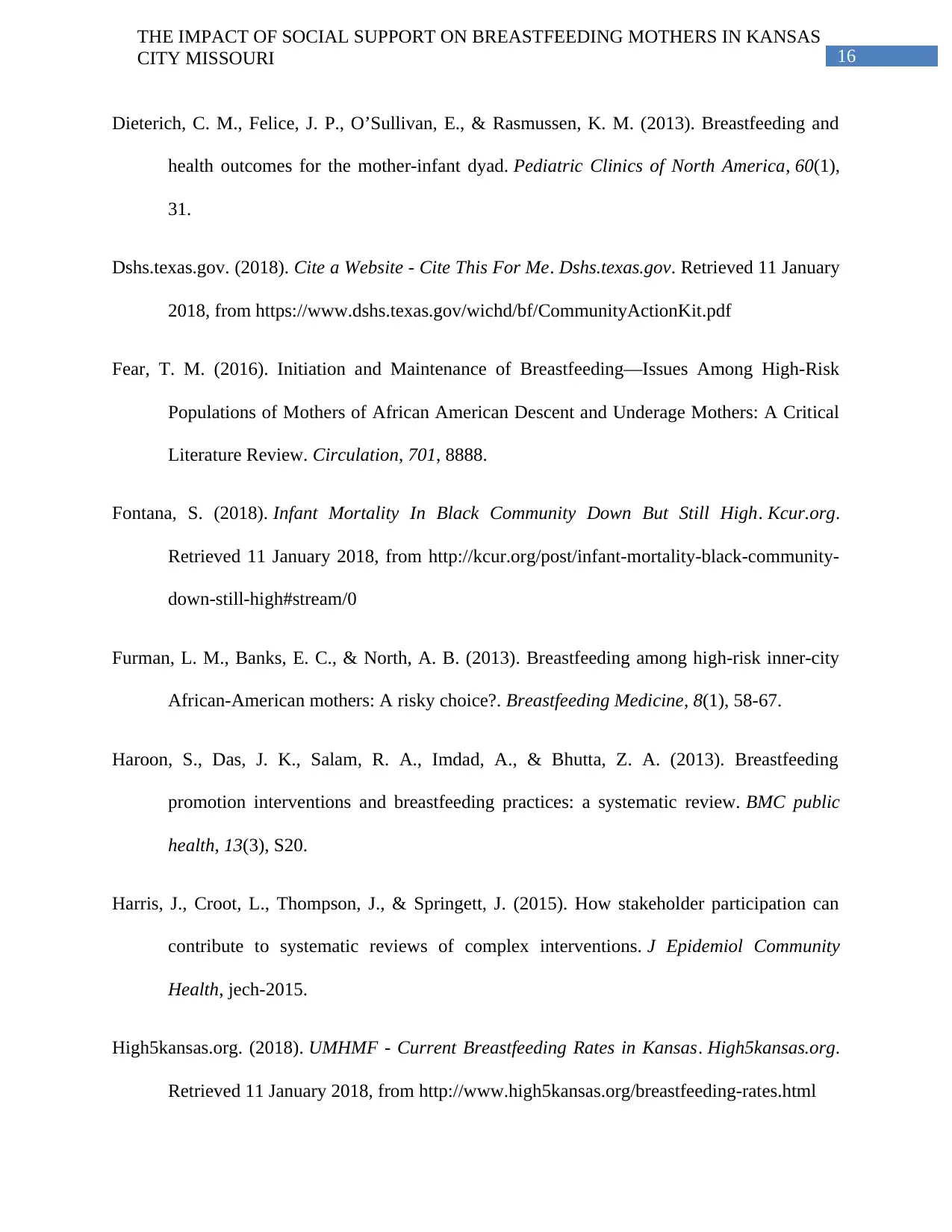
16
THE IMPACT OF SOCIAL SUPPORT ON BREASTFEEDING MOTHERS IN KANSAS
CITY MISSOURI
Dieterich, C. M., Felice, J. P., O’Sullivan, E., & Rasmussen, K. M. (2013). Breastfeeding and
health outcomes for the mother-infant dyad. Pediatric Clinics of North America, 60(1),
31.
Dshs.texas.gov. (2018). Cite a Website - Cite This For Me. Dshs.texas.gov. Retrieved 11 January
2018, from https://www.dshs.texas.gov/wichd/bf/CommunityActionKit.pdf
Fear, T. M. (2016). Initiation and Maintenance of Breastfeeding—Issues Among High-Risk
Populations of Mothers of African American Descent and Underage Mothers: A Critical
Literature Review. Circulation, 701, 8888.
Fontana, S. (2018). Infant Mortality In Black Community Down But Still High. Kcur.org.
Retrieved 11 January 2018, from http://kcur.org/post/infant-mortality-black-community-
down-still-high#stream/0
Furman, L. M., Banks, E. C., & North, A. B. (2013). Breastfeeding among high-risk inner-city
African-American mothers: A risky choice?. Breastfeeding Medicine, 8(1), 58-67.
Haroon, S., Das, J. K., Salam, R. A., Imdad, A., & Bhutta, Z. A. (2013). Breastfeeding
promotion interventions and breastfeeding practices: a systematic review. BMC public
health, 13(3), S20.
Harris, J., Croot, L., Thompson, J., & Springett, J. (2015). How stakeholder participation can
contribute to systematic reviews of complex interventions. J Epidemiol Community
Health, jech-2015.
High5kansas.org. (2018). UMHMF - Current Breastfeeding Rates in Kansas. High5kansas.org.
Retrieved 11 January 2018, from http://www.high5kansas.org/breastfeeding-rates.html
THE IMPACT OF SOCIAL SUPPORT ON BREASTFEEDING MOTHERS IN KANSAS
CITY MISSOURI
Dieterich, C. M., Felice, J. P., O’Sullivan, E., & Rasmussen, K. M. (2013). Breastfeeding and
health outcomes for the mother-infant dyad. Pediatric Clinics of North America, 60(1),
31.
Dshs.texas.gov. (2018). Cite a Website - Cite This For Me. Dshs.texas.gov. Retrieved 11 January
2018, from https://www.dshs.texas.gov/wichd/bf/CommunityActionKit.pdf
Fear, T. M. (2016). Initiation and Maintenance of Breastfeeding—Issues Among High-Risk
Populations of Mothers of African American Descent and Underage Mothers: A Critical
Literature Review. Circulation, 701, 8888.
Fontana, S. (2018). Infant Mortality In Black Community Down But Still High. Kcur.org.
Retrieved 11 January 2018, from http://kcur.org/post/infant-mortality-black-community-
down-still-high#stream/0
Furman, L. M., Banks, E. C., & North, A. B. (2013). Breastfeeding among high-risk inner-city
African-American mothers: A risky choice?. Breastfeeding Medicine, 8(1), 58-67.
Haroon, S., Das, J. K., Salam, R. A., Imdad, A., & Bhutta, Z. A. (2013). Breastfeeding
promotion interventions and breastfeeding practices: a systematic review. BMC public
health, 13(3), S20.
Harris, J., Croot, L., Thompson, J., & Springett, J. (2015). How stakeholder participation can
contribute to systematic reviews of complex interventions. J Epidemiol Community
Health, jech-2015.
High5kansas.org. (2018). UMHMF - Current Breastfeeding Rates in Kansas. High5kansas.org.
Retrieved 11 January 2018, from http://www.high5kansas.org/breastfeeding-rates.html

17
THE IMPACT OF SOCIAL SUPPORT ON BREASTFEEDING MOTHERS IN KANSAS
CITY MISSOURI
Johnson, A., Kirk, R., Rosenblum, K. L., & Muzik, M. (2015). Enhancing breastfeeding rates
among African American women: A systematic review of current psychosocial
interventions. Breastfeeding Medicine, 10(1), 45-62.
Kansashealthmatters.org. (2018). Kansas Health Matters :: Better health through
community. Kansashealthmatters.org. Retrieved 11 January 2018, from
http://www.kansashealthmatters.org/index.php?
module=Tiles&controller=index&action=display&alias=Breastfeeding
Muchacha, M., & Mtetwa, E. (2015). Social and Economic Barriers to Exclusive Breast Feeding
In Rural Zimbabwe. International Journal of MCH and AIDS, 3(1), 16.
Ncbi.nlm.nih.gov. (2018). Barriers to Breastfeeding in the United States. Ncbi.nlm.nih.gov.
Retrieved 11 January 2018, from https://www.ncbi.nlm.nih.gov/books/NBK52688/
Nodo, L. T. (2014). Breastfeeding Support and How it Influences Breastfeeding Rates (Doctoral
dissertation, Kent State University).
Pérez-Escamilla, R., Curry, L., Minhas, D., Taylor, L., & Bradley, E. (2012). Scaling up of
breastfeeding promotion programs in low-and middle-income countries: the
“breastfeeding gear” model. Advances in Nutrition: An International Review
Journal, 3(6), 790-800.
Sipsma, H. L., Jones, K. L., & Cole-Lewis, H. (2015). Breastfeeding among adolescent mothers:
a systematic review of Interventions from high-income countries. Journal of Human
Lactation, 31(2), 221-229.
THE IMPACT OF SOCIAL SUPPORT ON BREASTFEEDING MOTHERS IN KANSAS
CITY MISSOURI
Johnson, A., Kirk, R., Rosenblum, K. L., & Muzik, M. (2015). Enhancing breastfeeding rates
among African American women: A systematic review of current psychosocial
interventions. Breastfeeding Medicine, 10(1), 45-62.
Kansashealthmatters.org. (2018). Kansas Health Matters :: Better health through
community. Kansashealthmatters.org. Retrieved 11 January 2018, from
http://www.kansashealthmatters.org/index.php?
module=Tiles&controller=index&action=display&alias=Breastfeeding
Muchacha, M., & Mtetwa, E. (2015). Social and Economic Barriers to Exclusive Breast Feeding
In Rural Zimbabwe. International Journal of MCH and AIDS, 3(1), 16.
Ncbi.nlm.nih.gov. (2018). Barriers to Breastfeeding in the United States. Ncbi.nlm.nih.gov.
Retrieved 11 January 2018, from https://www.ncbi.nlm.nih.gov/books/NBK52688/
Nodo, L. T. (2014). Breastfeeding Support and How it Influences Breastfeeding Rates (Doctoral
dissertation, Kent State University).
Pérez-Escamilla, R., Curry, L., Minhas, D., Taylor, L., & Bradley, E. (2012). Scaling up of
breastfeeding promotion programs in low-and middle-income countries: the
“breastfeeding gear” model. Advances in Nutrition: An International Review
Journal, 3(6), 790-800.
Sipsma, H. L., Jones, K. L., & Cole-Lewis, H. (2015). Breastfeeding among adolescent mothers:
a systematic review of Interventions from high-income countries. Journal of Human
Lactation, 31(2), 221-229.
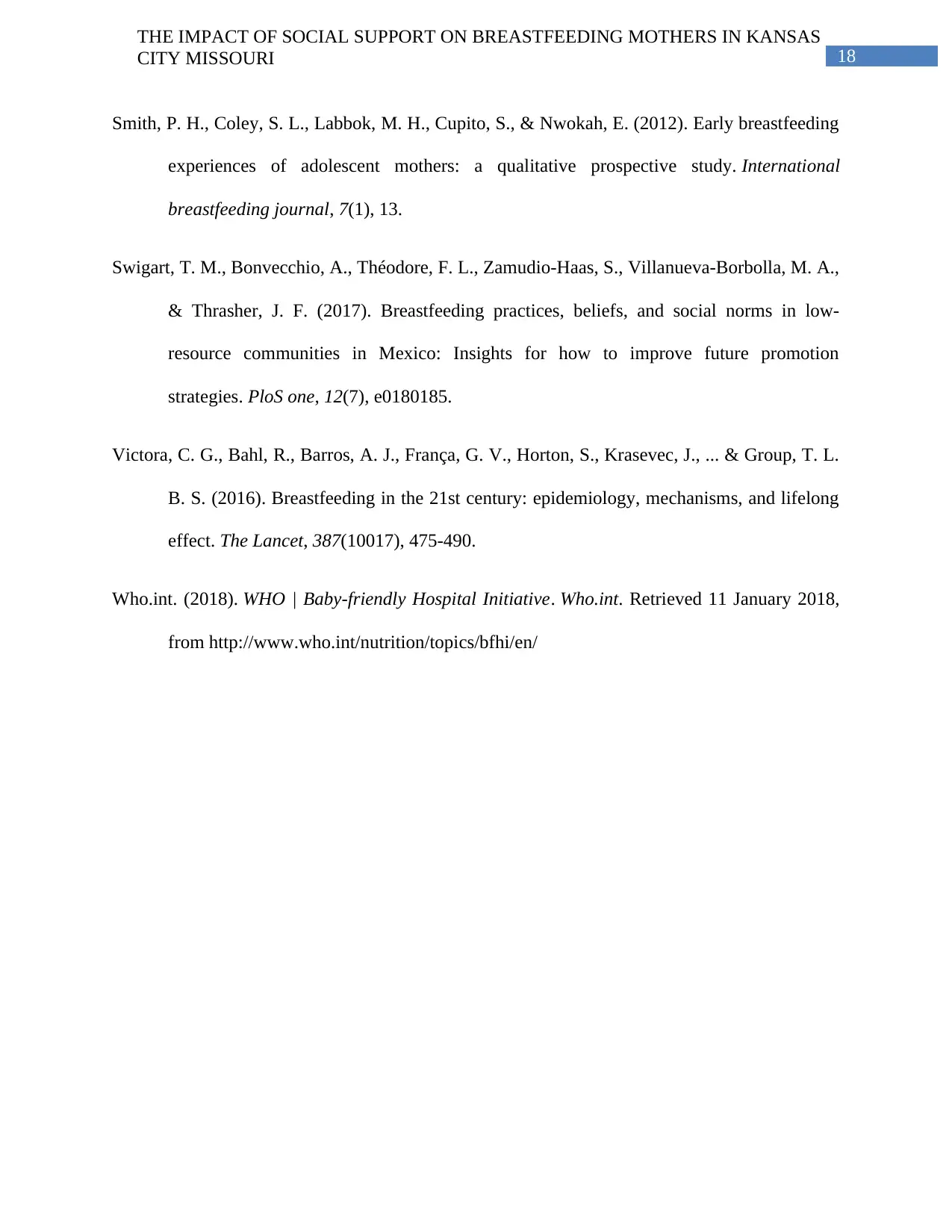
18
THE IMPACT OF SOCIAL SUPPORT ON BREASTFEEDING MOTHERS IN KANSAS
CITY MISSOURI
Smith, P. H., Coley, S. L., Labbok, M. H., Cupito, S., & Nwokah, E. (2012). Early breastfeeding
experiences of adolescent mothers: a qualitative prospective study. International
breastfeeding journal, 7(1), 13.
Swigart, T. M., Bonvecchio, A., Théodore, F. L., Zamudio-Haas, S., Villanueva-Borbolla, M. A.,
& Thrasher, J. F. (2017). Breastfeeding practices, beliefs, and social norms in low-
resource communities in Mexico: Insights for how to improve future promotion
strategies. PloS one, 12(7), e0180185.
Victora, C. G., Bahl, R., Barros, A. J., França, G. V., Horton, S., Krasevec, J., ... & Group, T. L.
B. S. (2016). Breastfeeding in the 21st century: epidemiology, mechanisms, and lifelong
effect. The Lancet, 387(10017), 475-490.
Who.int. (2018). WHO | Baby-friendly Hospital Initiative. Who.int. Retrieved 11 January 2018,
from http://www.who.int/nutrition/topics/bfhi/en/
THE IMPACT OF SOCIAL SUPPORT ON BREASTFEEDING MOTHERS IN KANSAS
CITY MISSOURI
Smith, P. H., Coley, S. L., Labbok, M. H., Cupito, S., & Nwokah, E. (2012). Early breastfeeding
experiences of adolescent mothers: a qualitative prospective study. International
breastfeeding journal, 7(1), 13.
Swigart, T. M., Bonvecchio, A., Théodore, F. L., Zamudio-Haas, S., Villanueva-Borbolla, M. A.,
& Thrasher, J. F. (2017). Breastfeeding practices, beliefs, and social norms in low-
resource communities in Mexico: Insights for how to improve future promotion
strategies. PloS one, 12(7), e0180185.
Victora, C. G., Bahl, R., Barros, A. J., França, G. V., Horton, S., Krasevec, J., ... & Group, T. L.
B. S. (2016). Breastfeeding in the 21st century: epidemiology, mechanisms, and lifelong
effect. The Lancet, 387(10017), 475-490.
Who.int. (2018). WHO | Baby-friendly Hospital Initiative. Who.int. Retrieved 11 January 2018,
from http://www.who.int/nutrition/topics/bfhi/en/
1 out of 19
![[object Object]](/_next/static/media/star-bottom.7253800d.svg)





